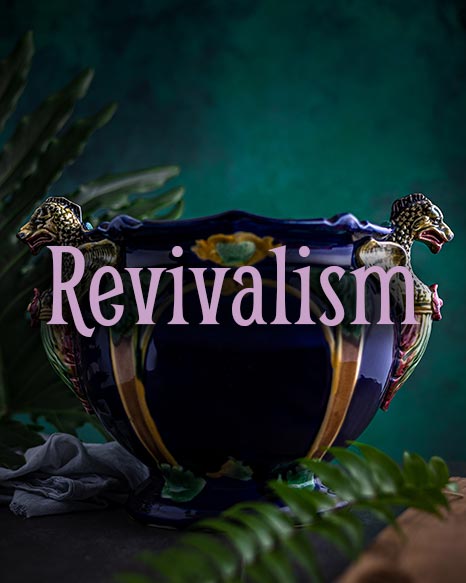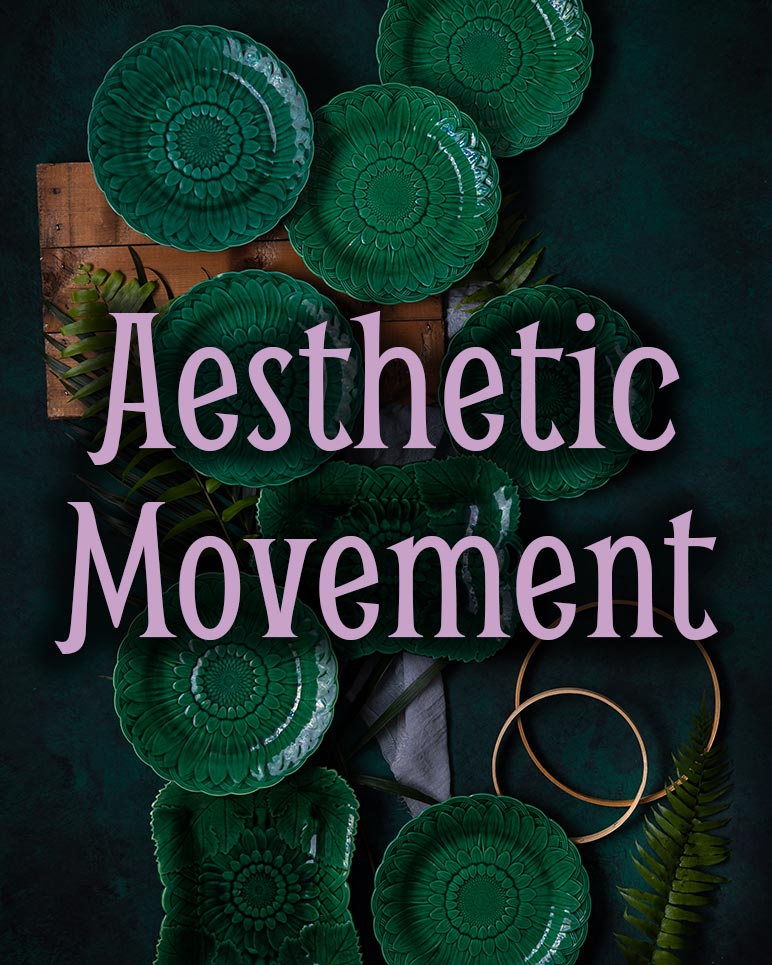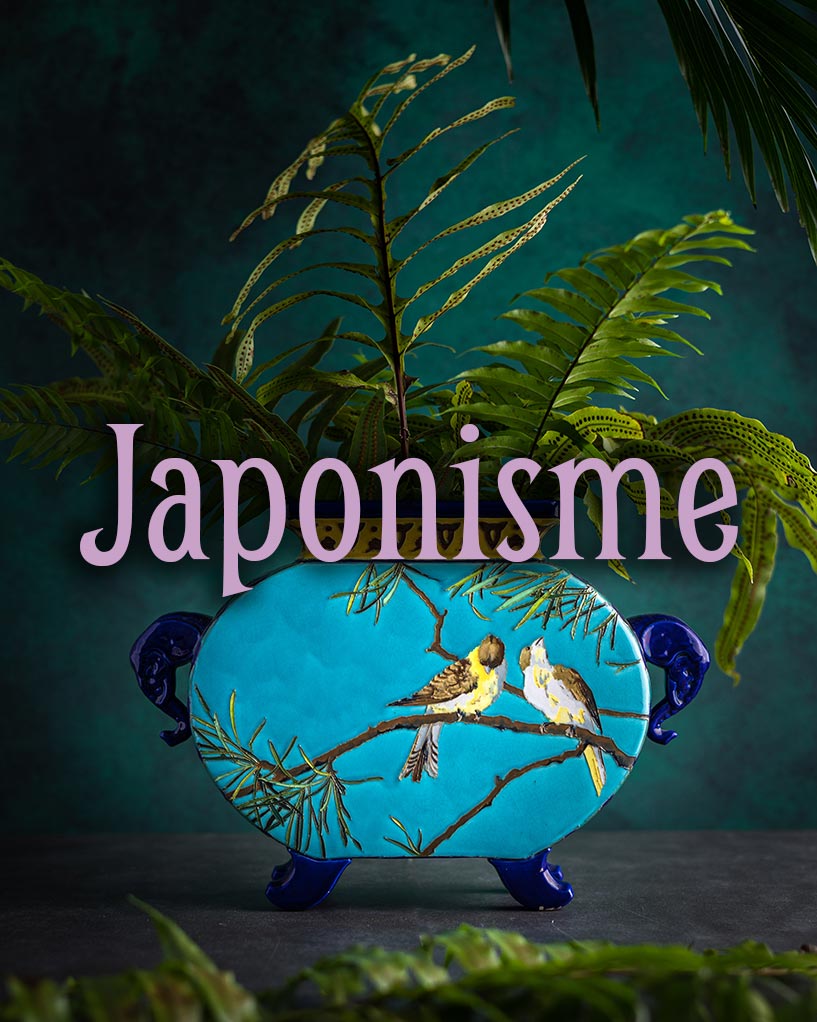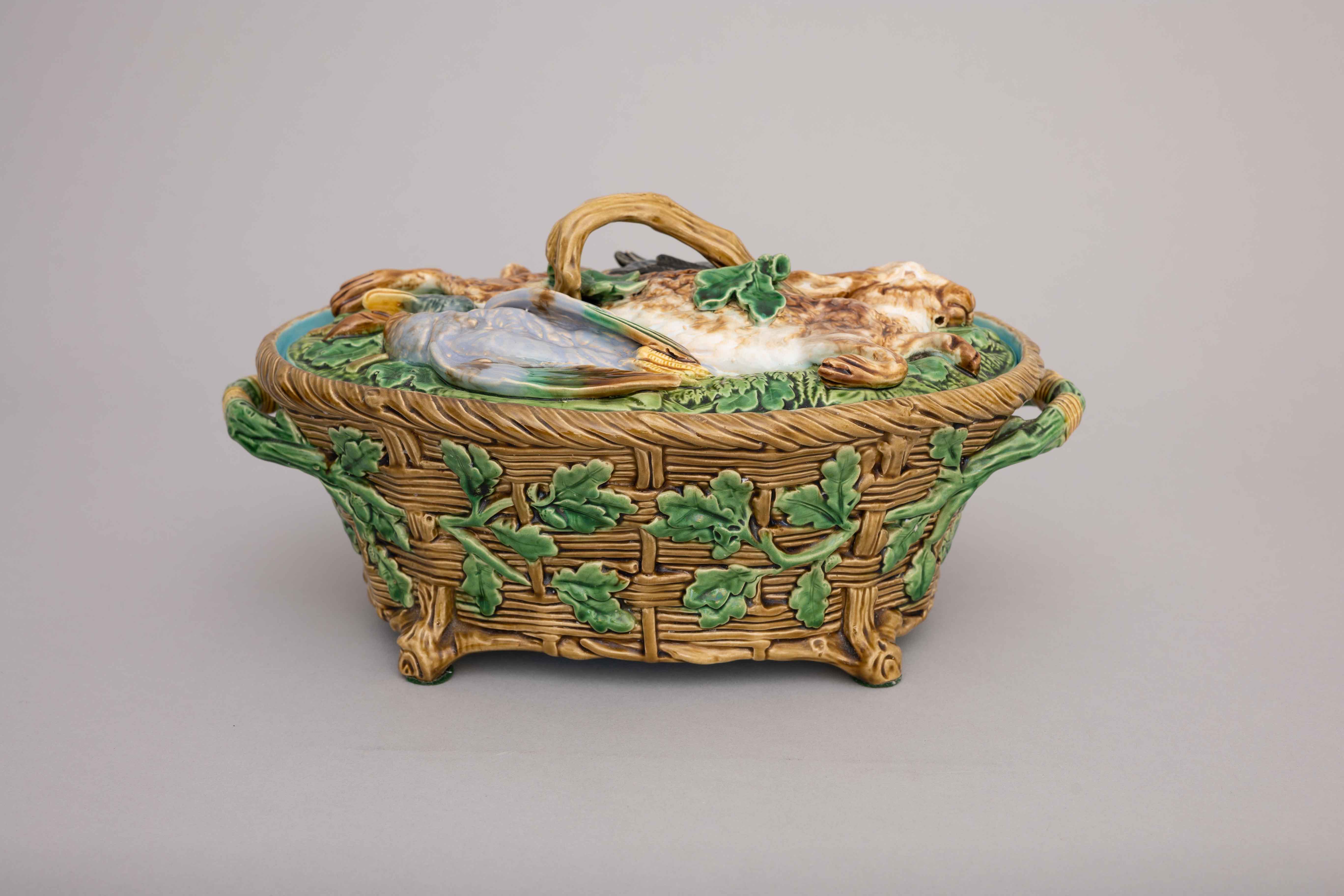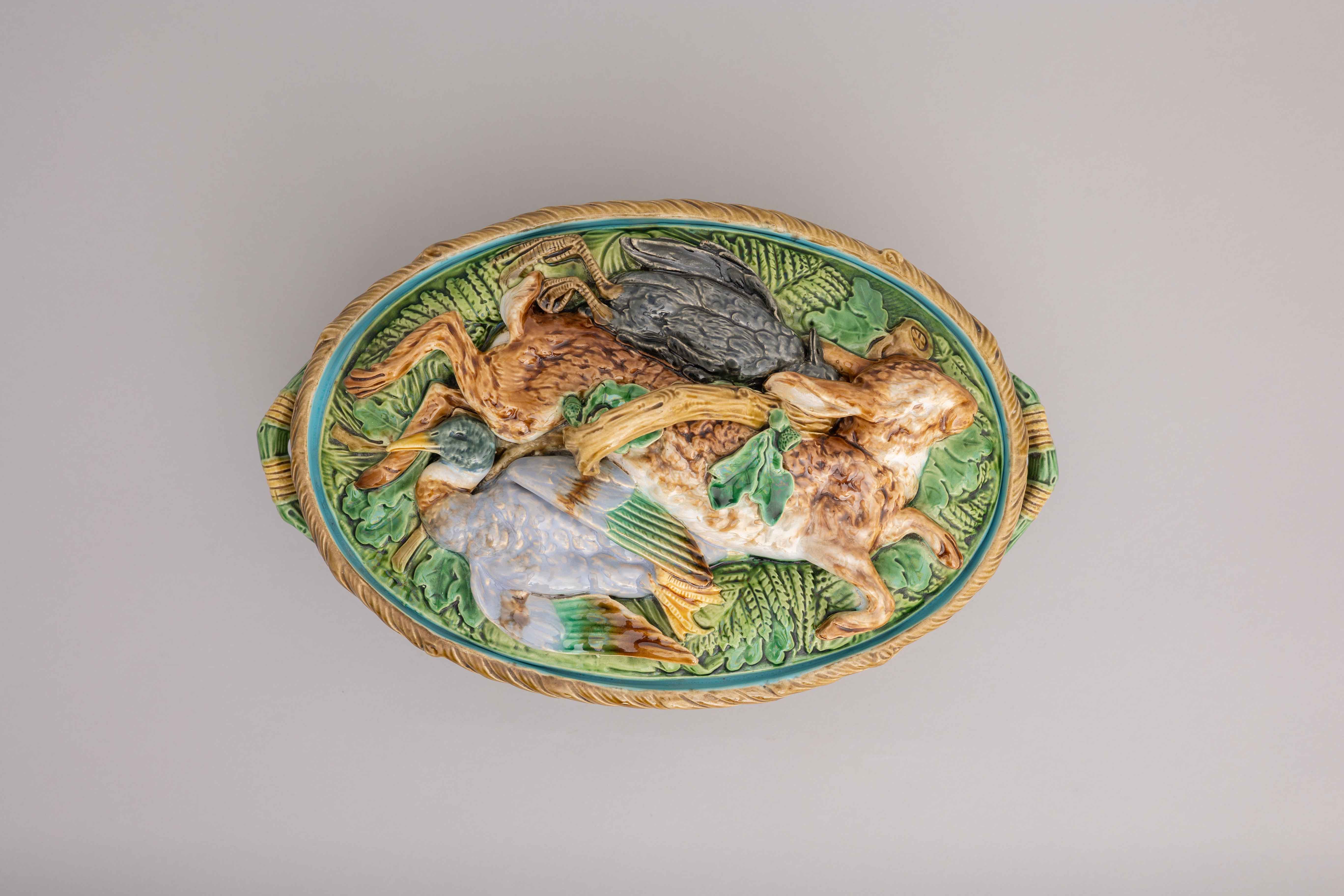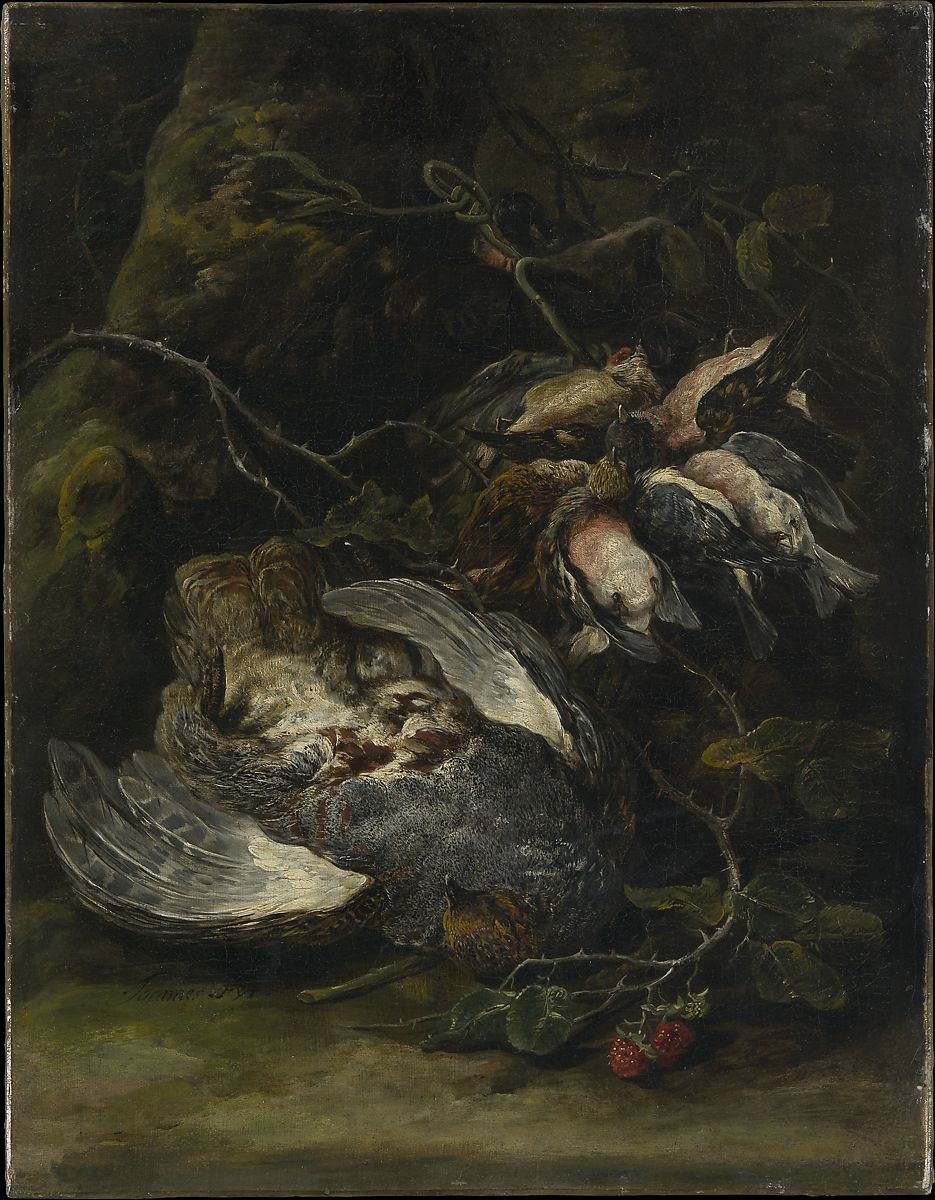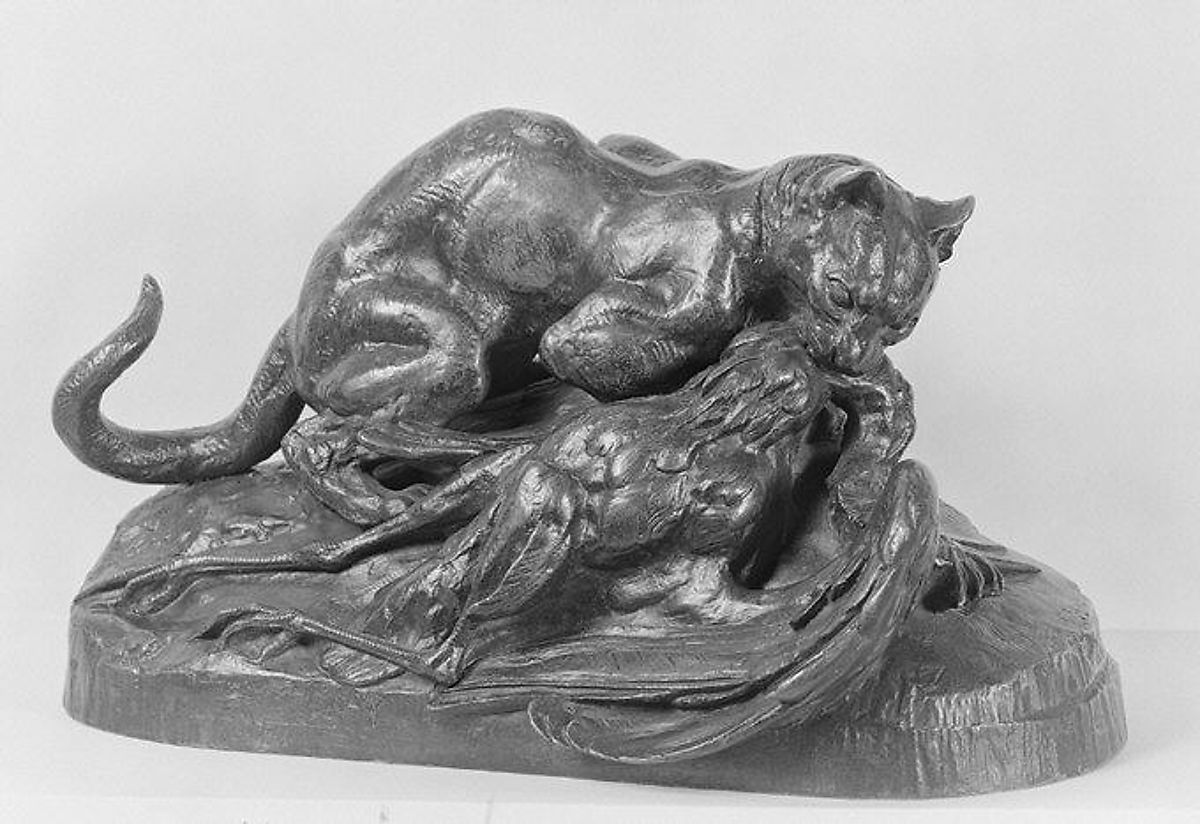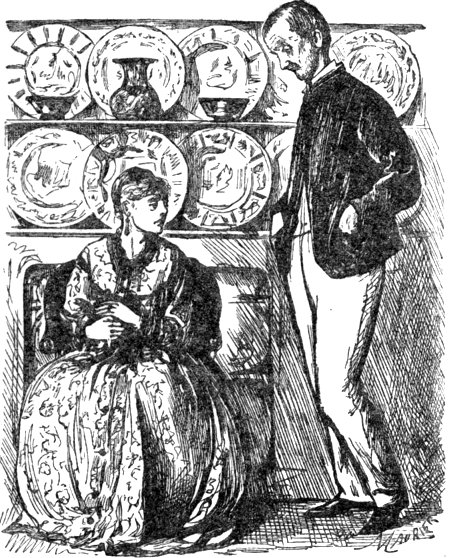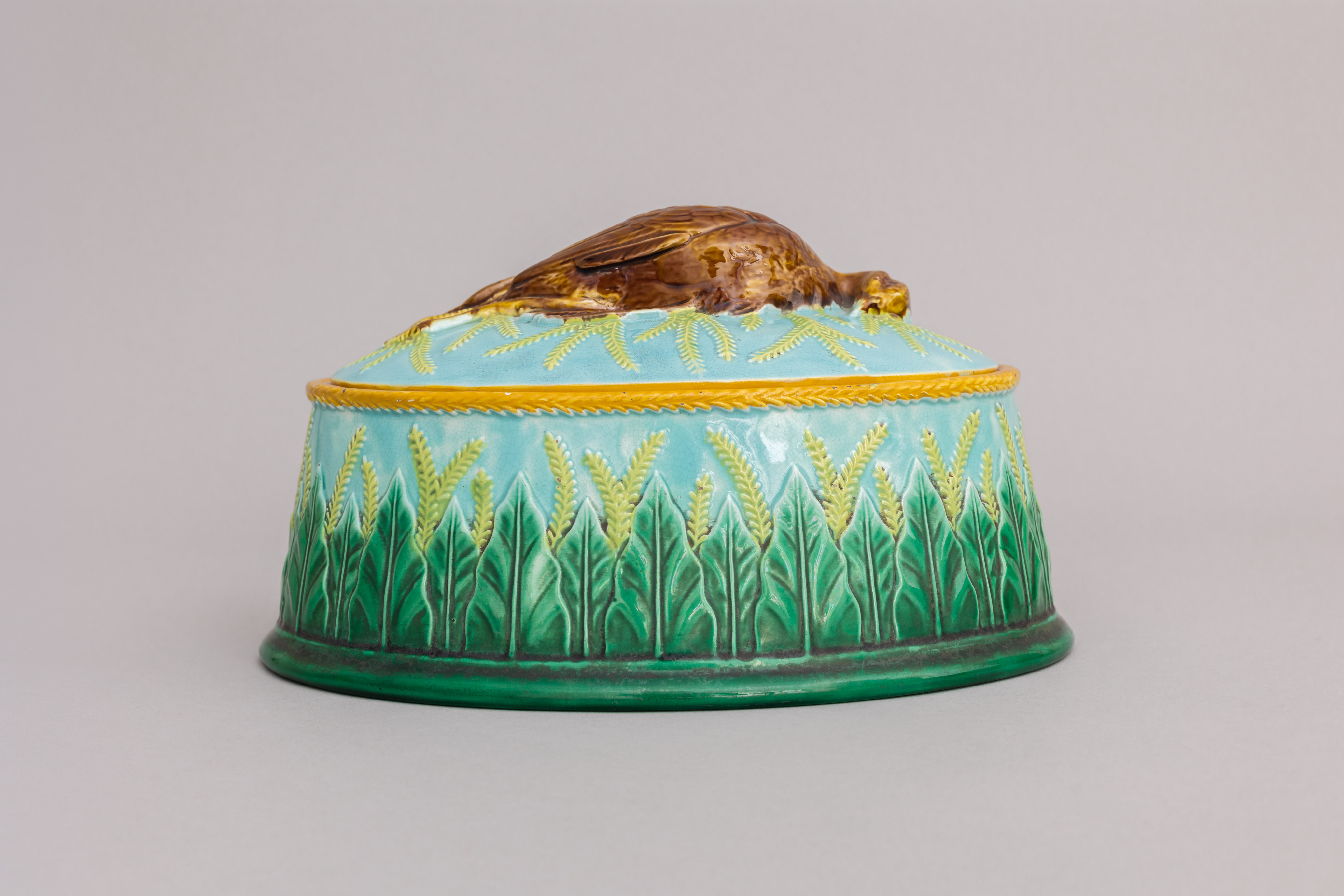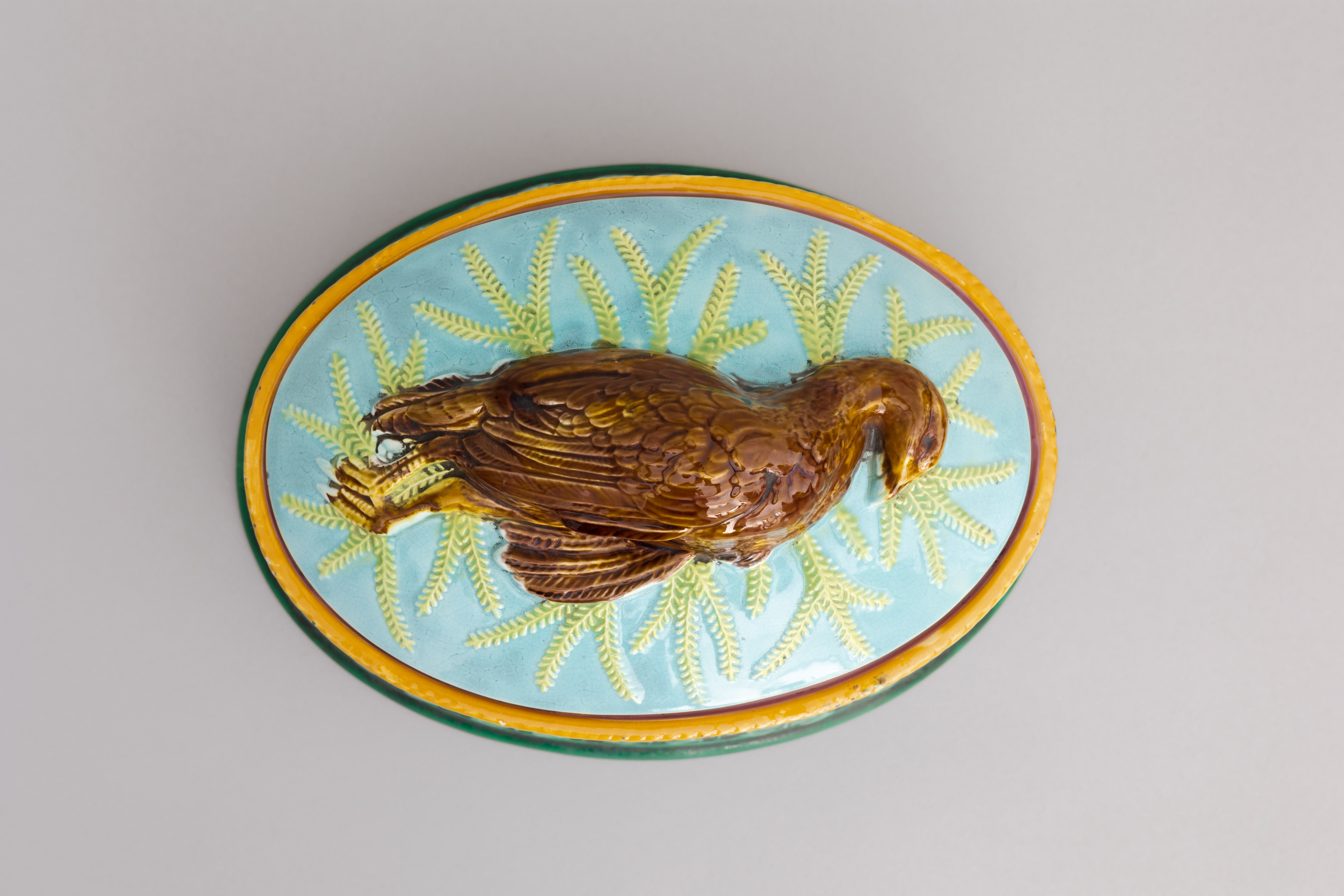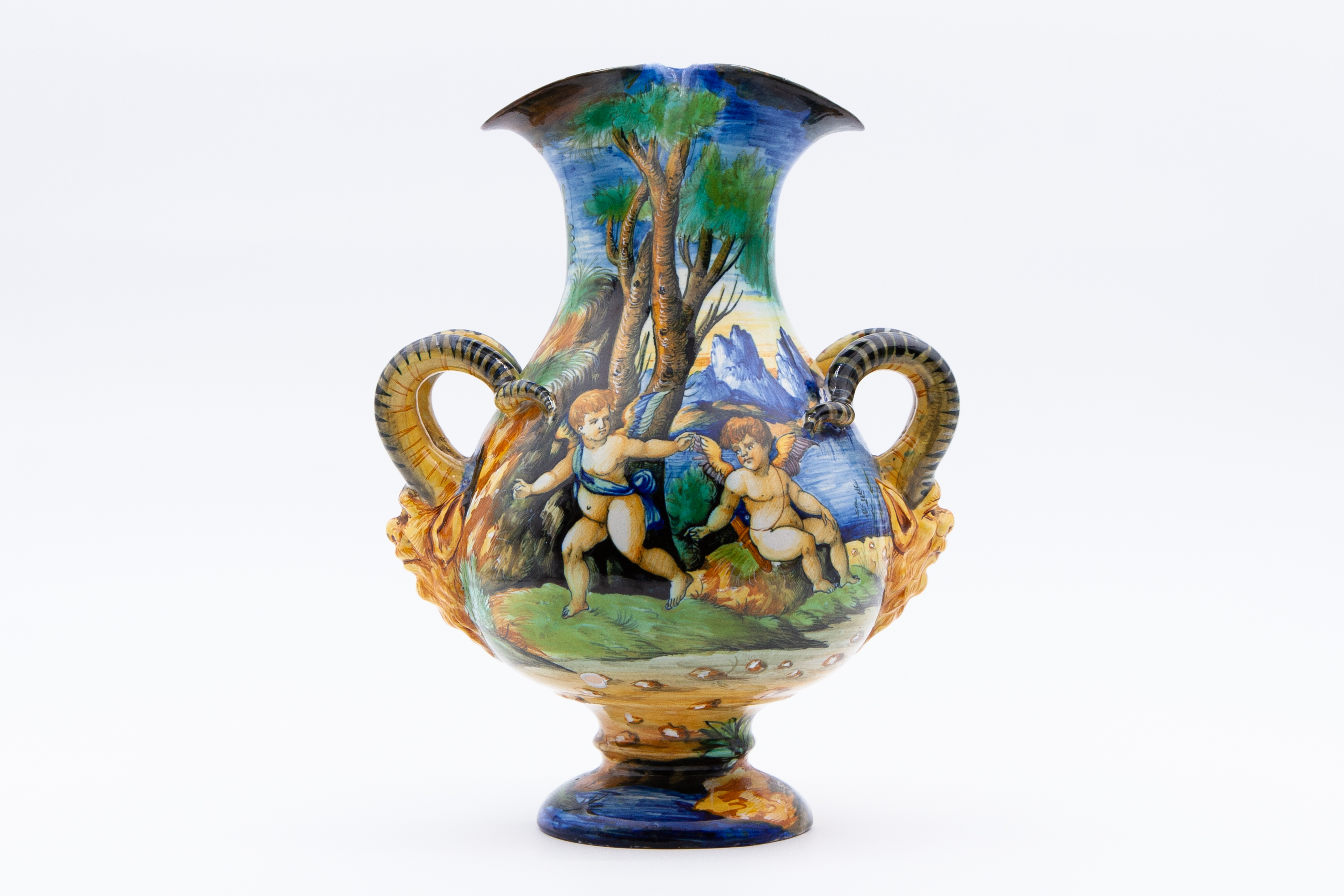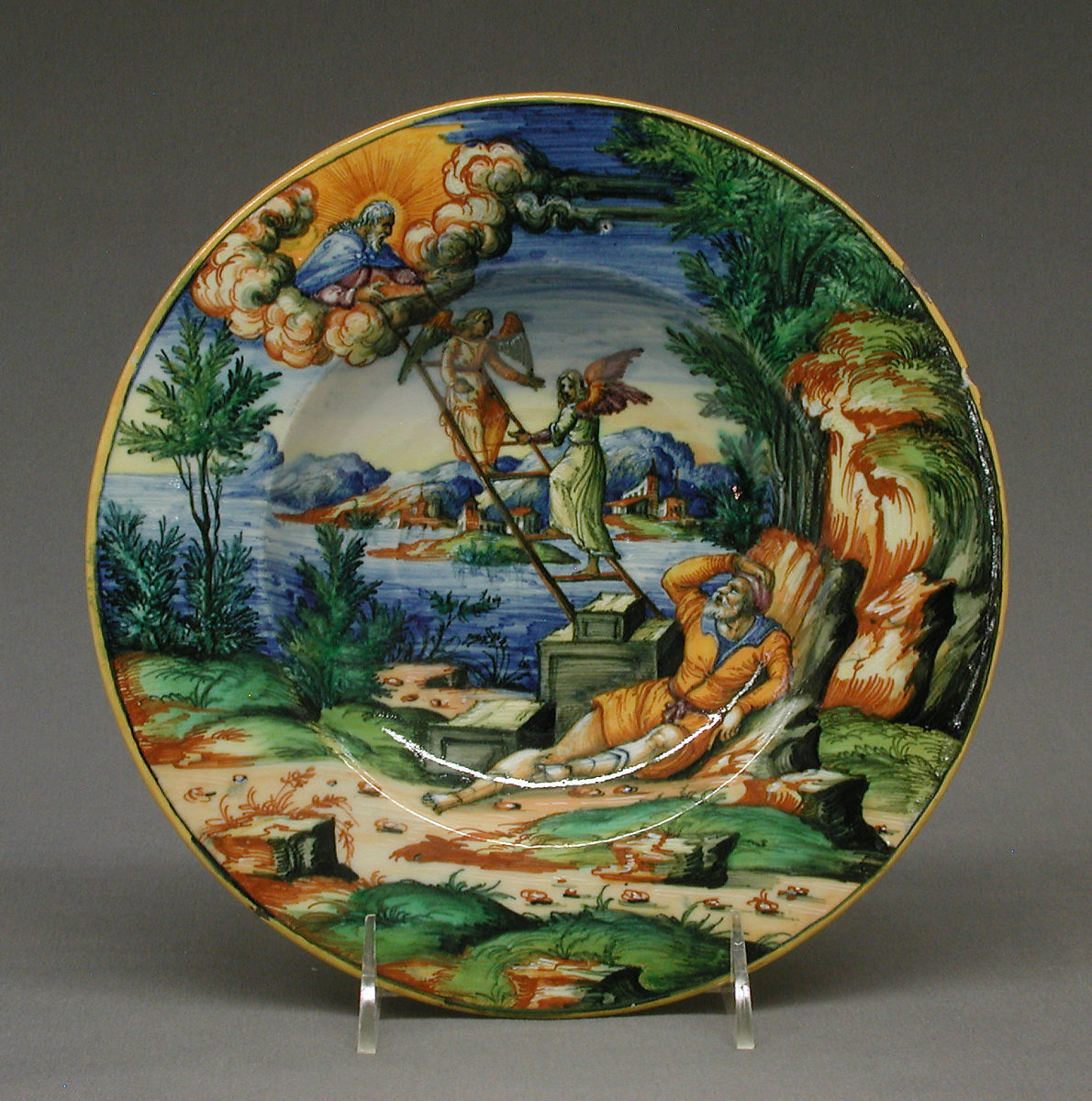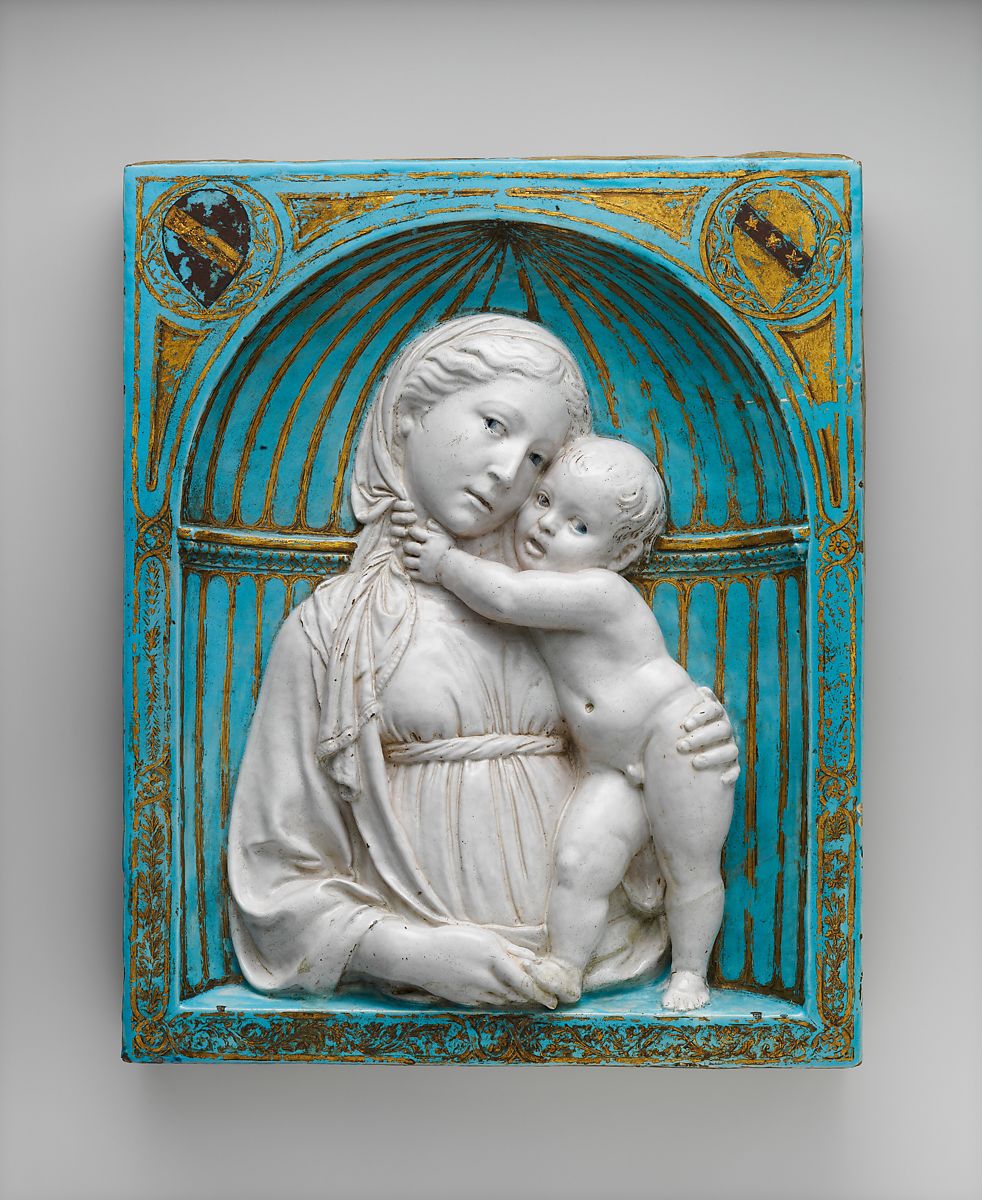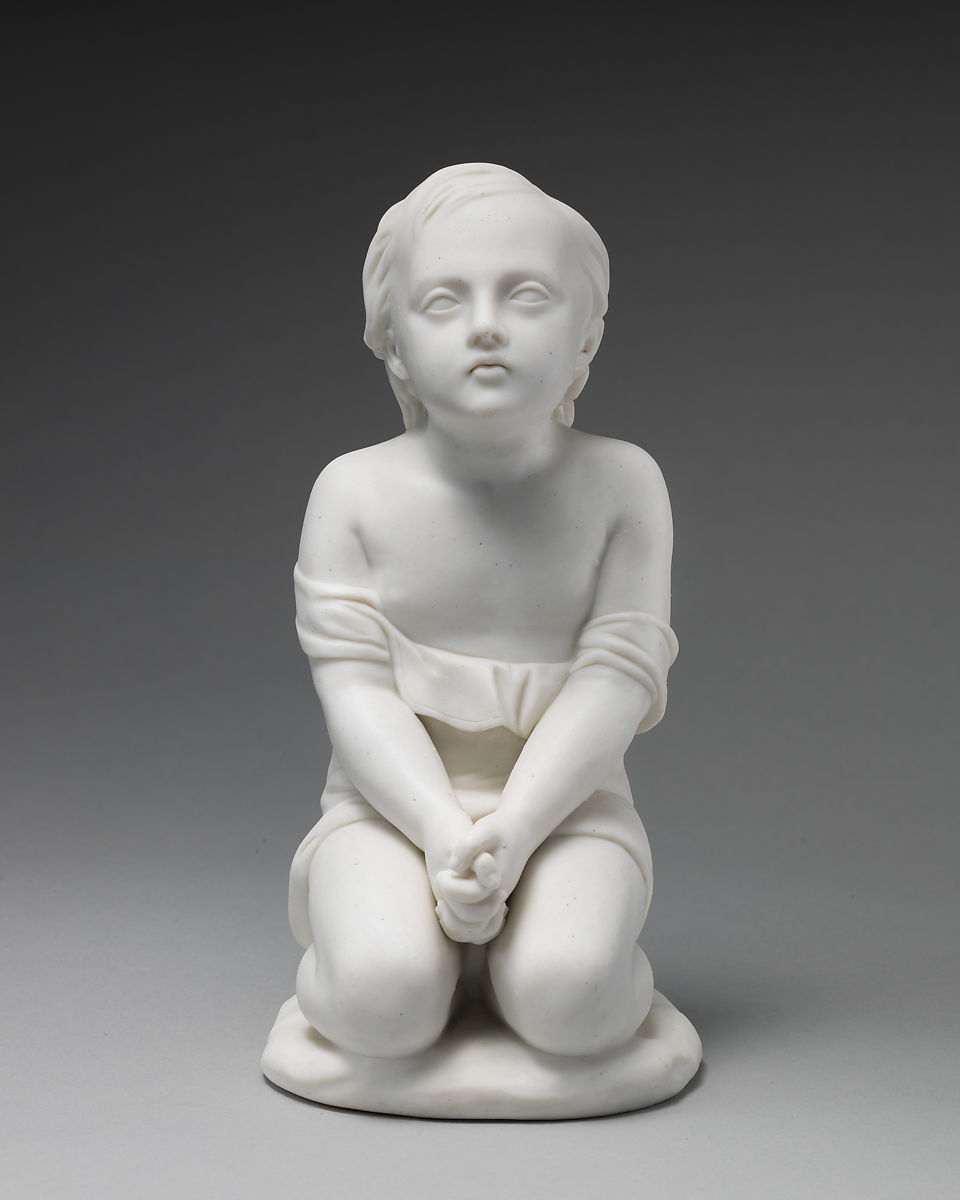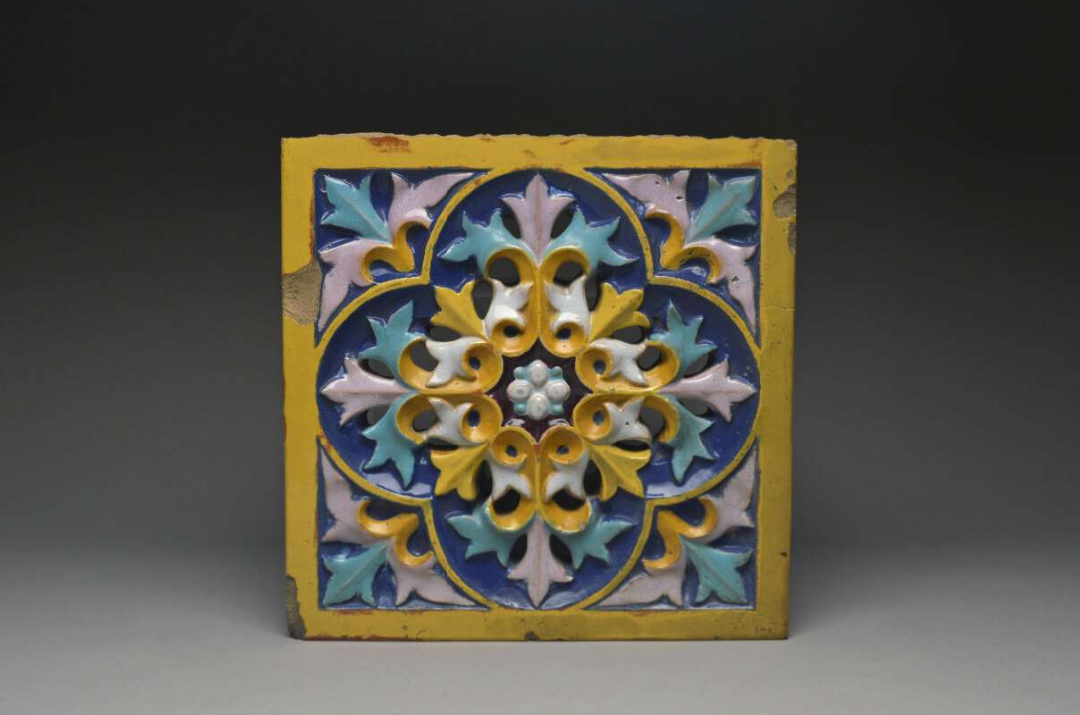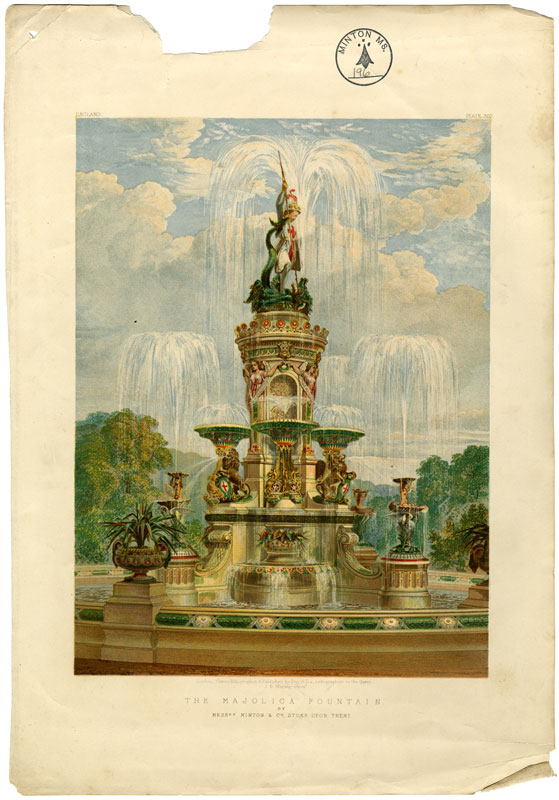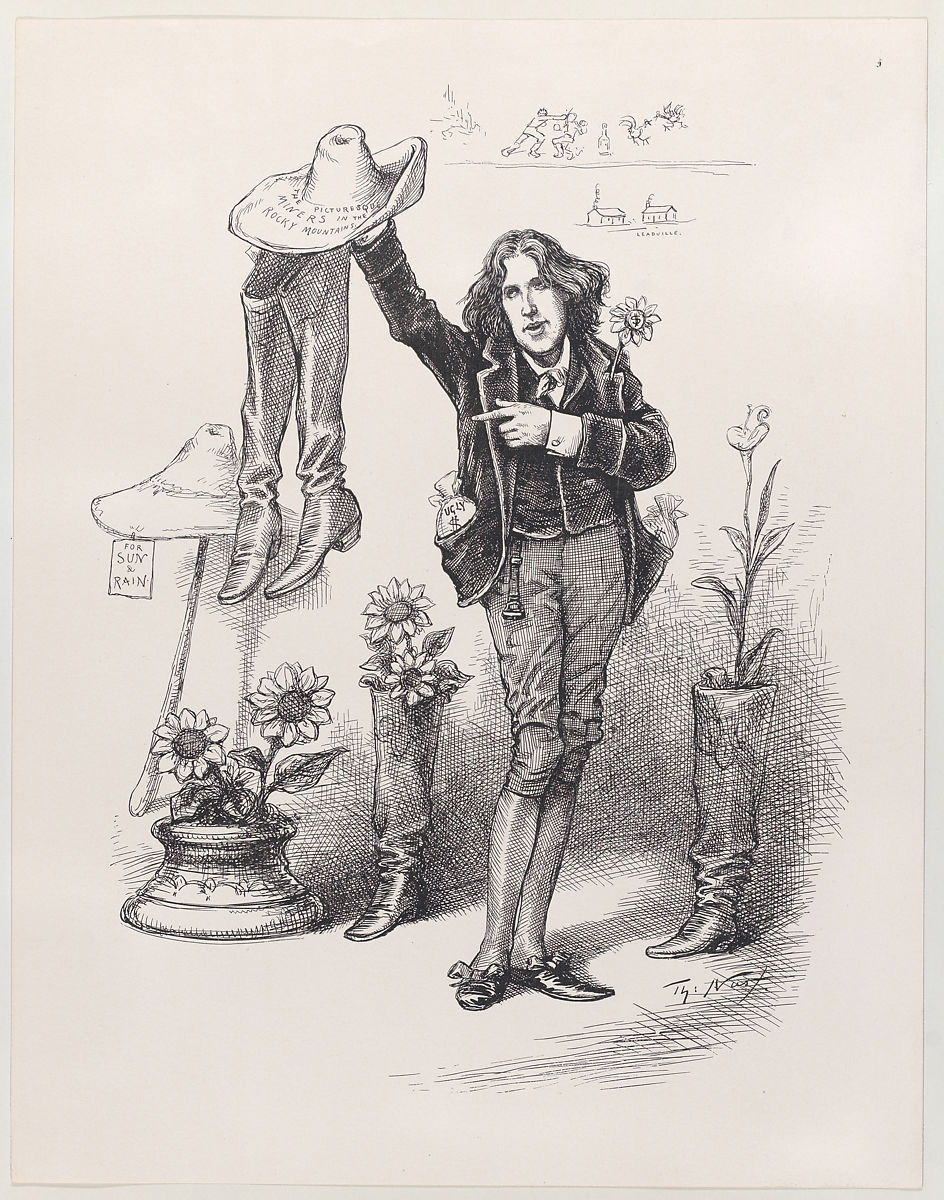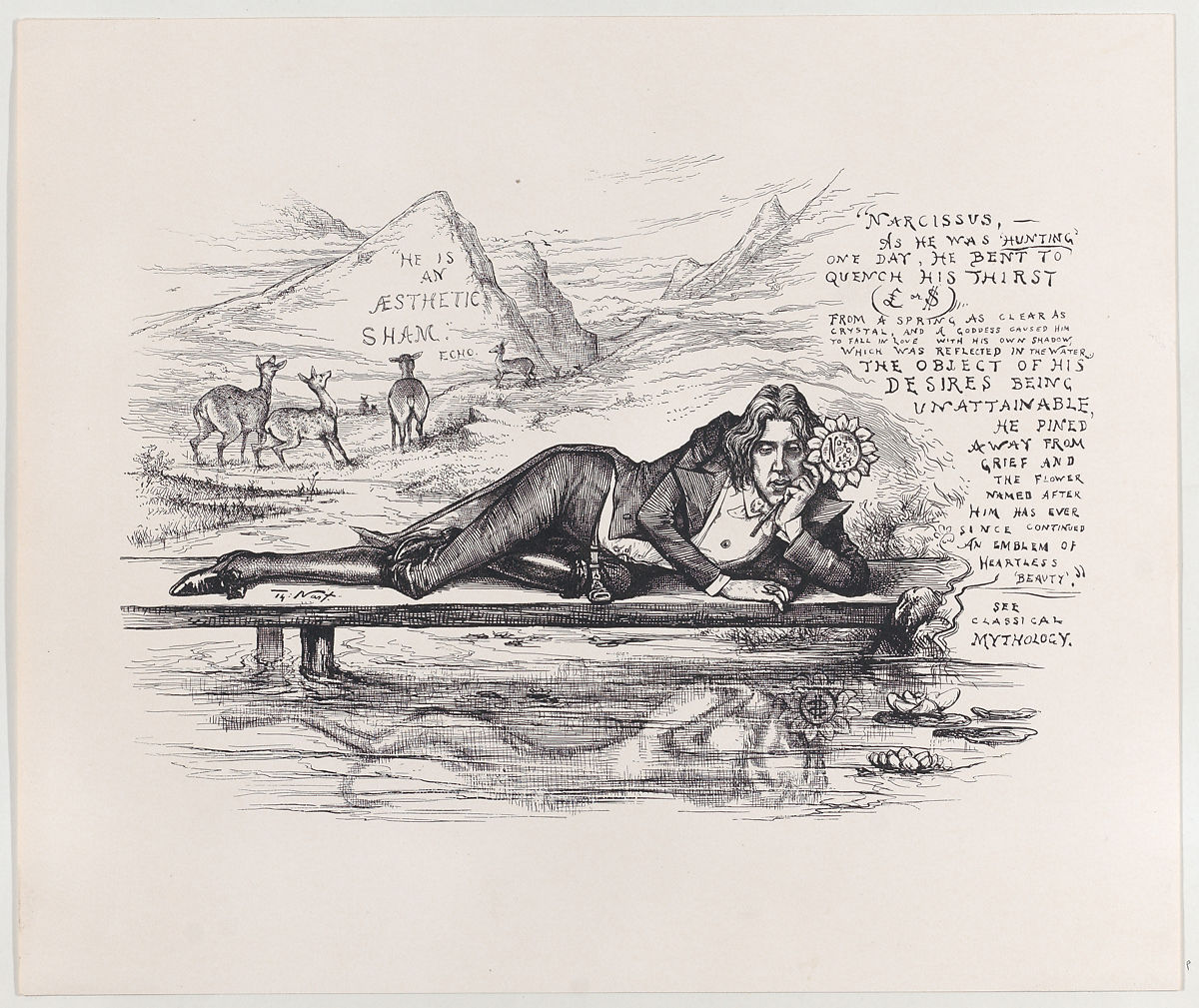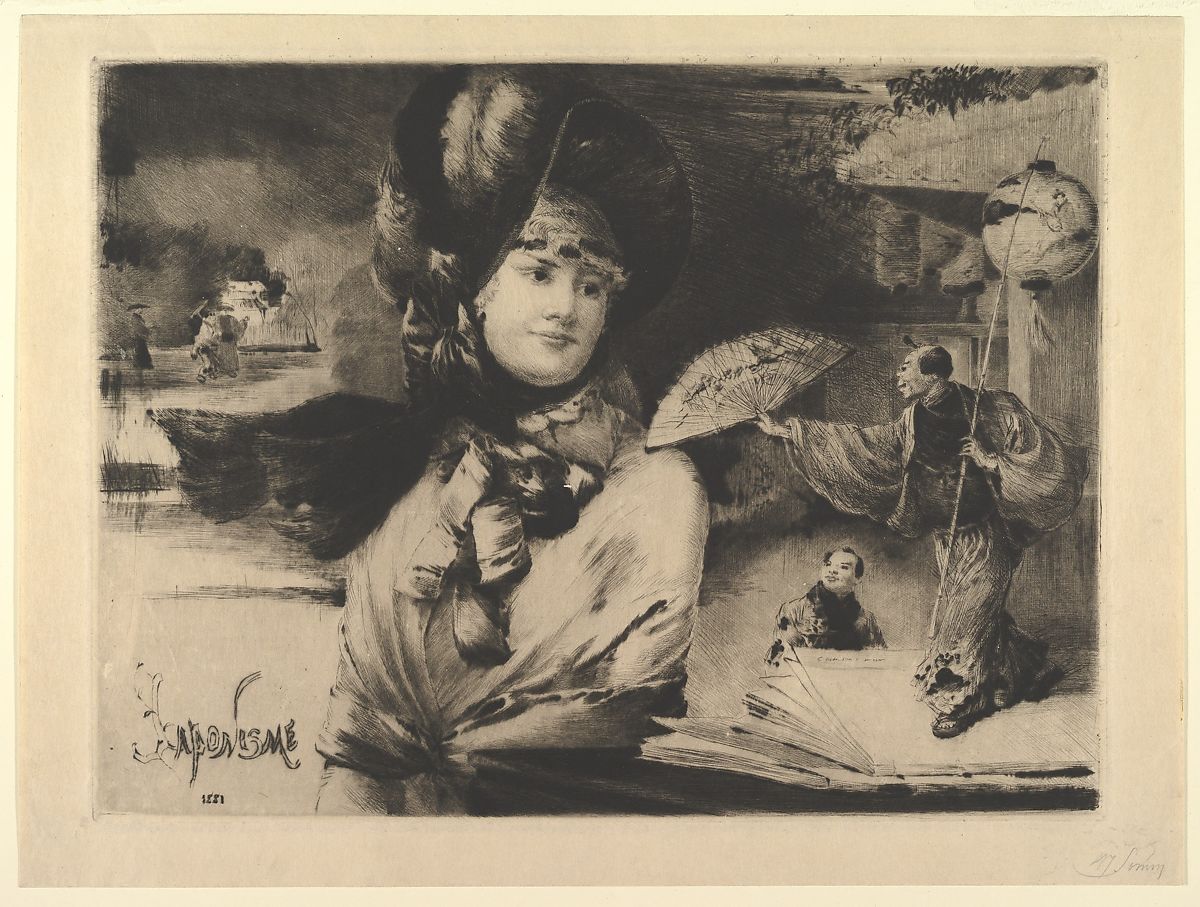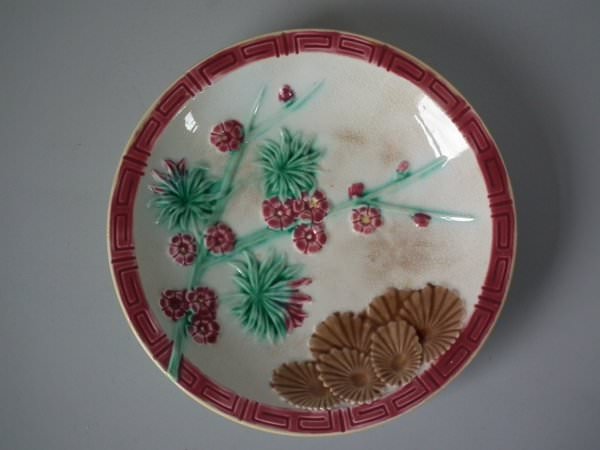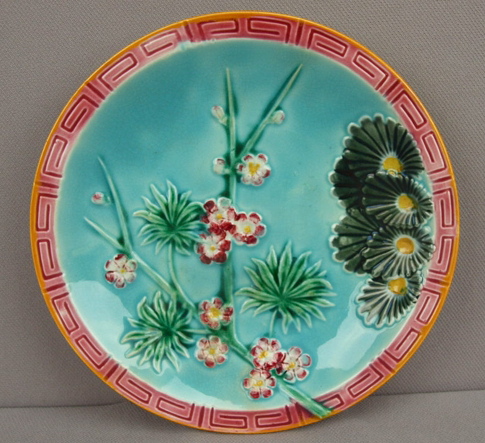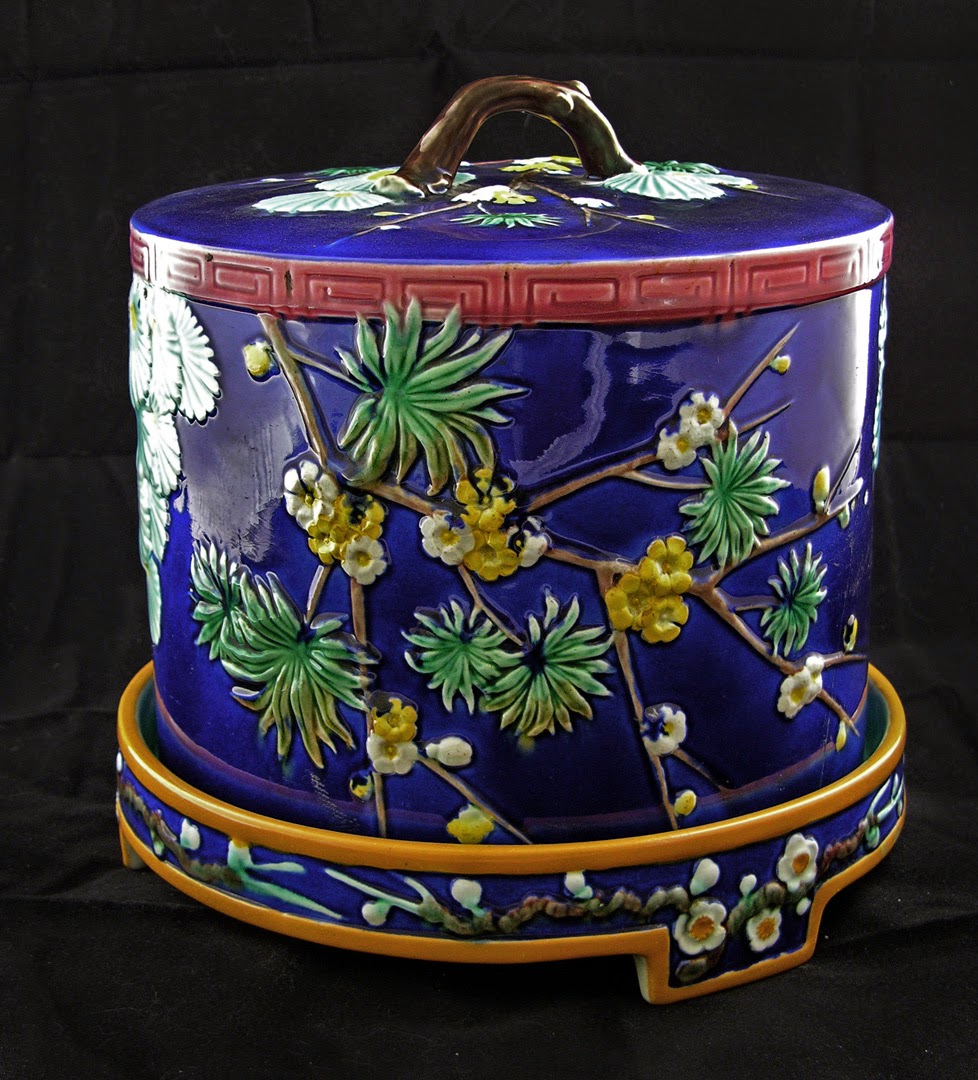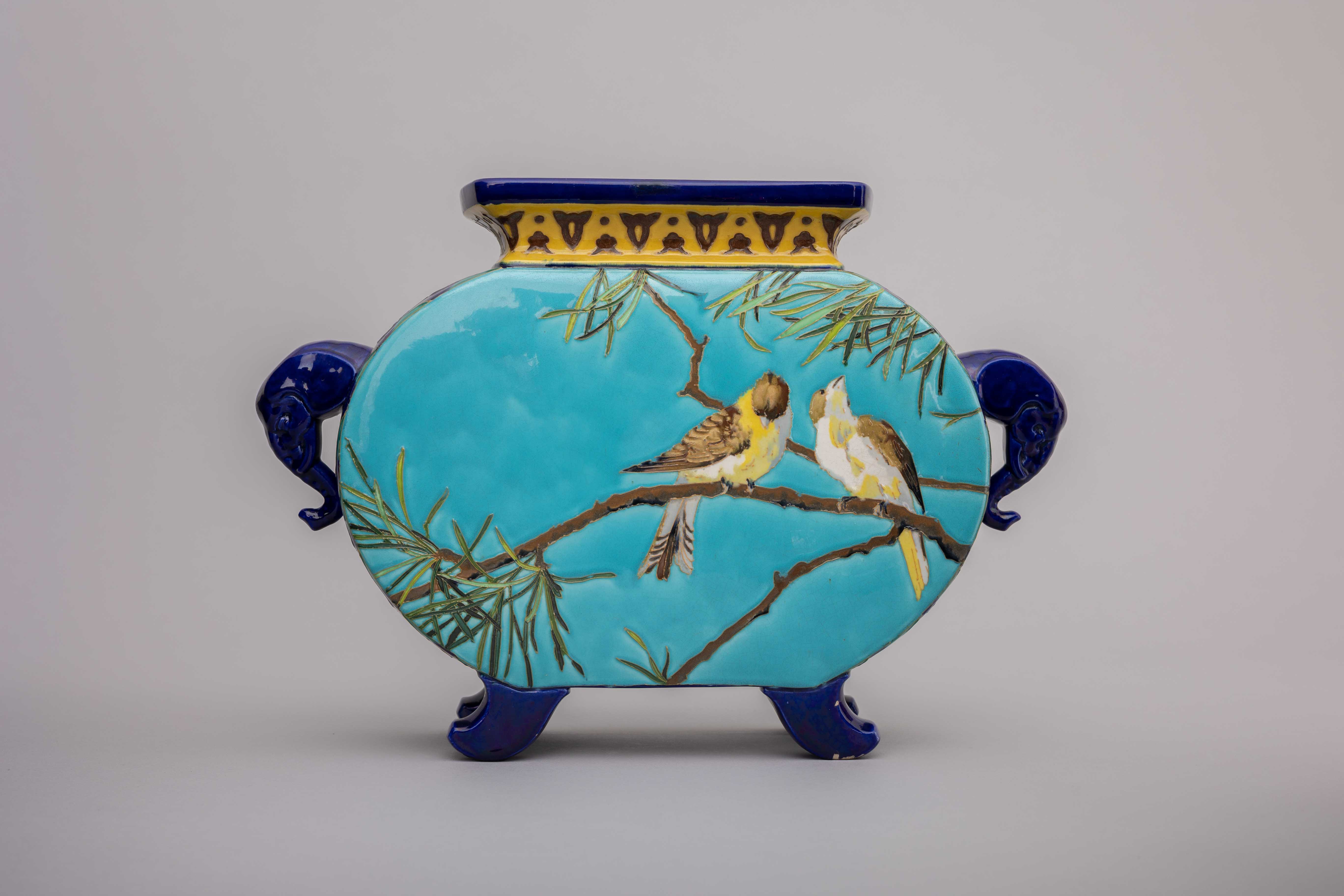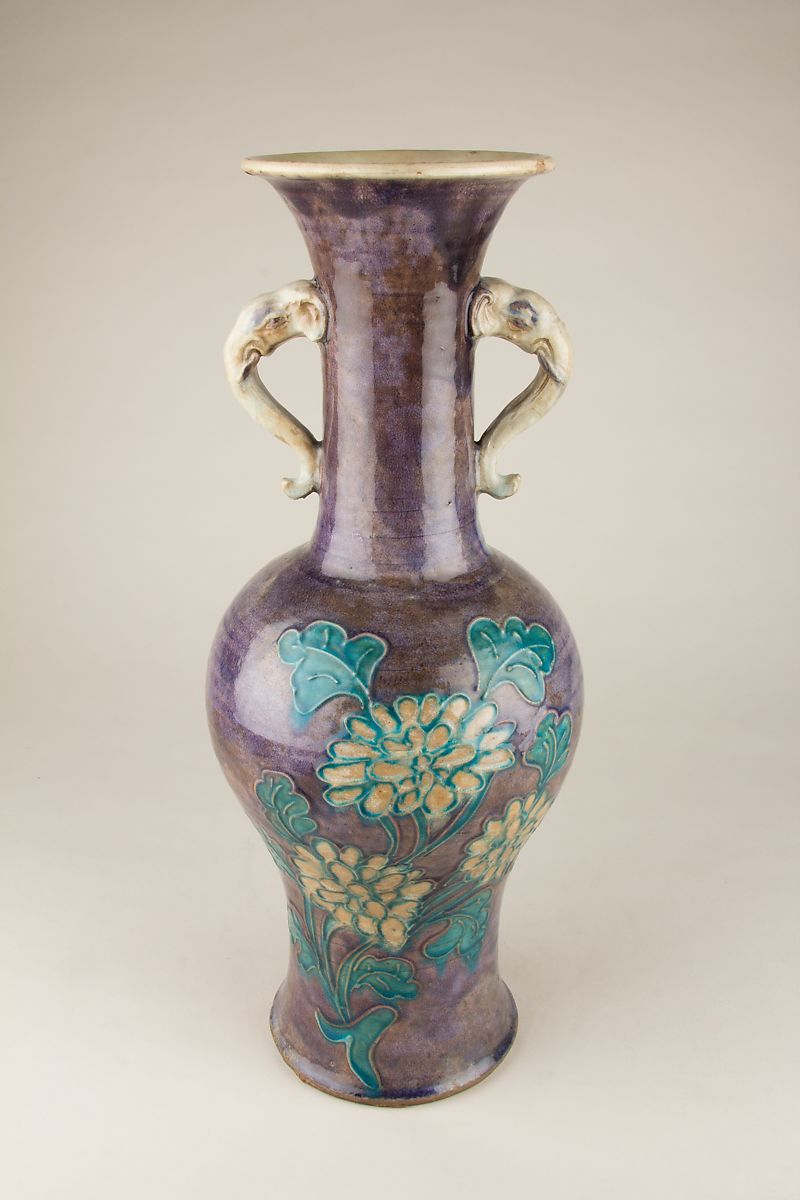The Majolica Movement
A Curation by Artistoric
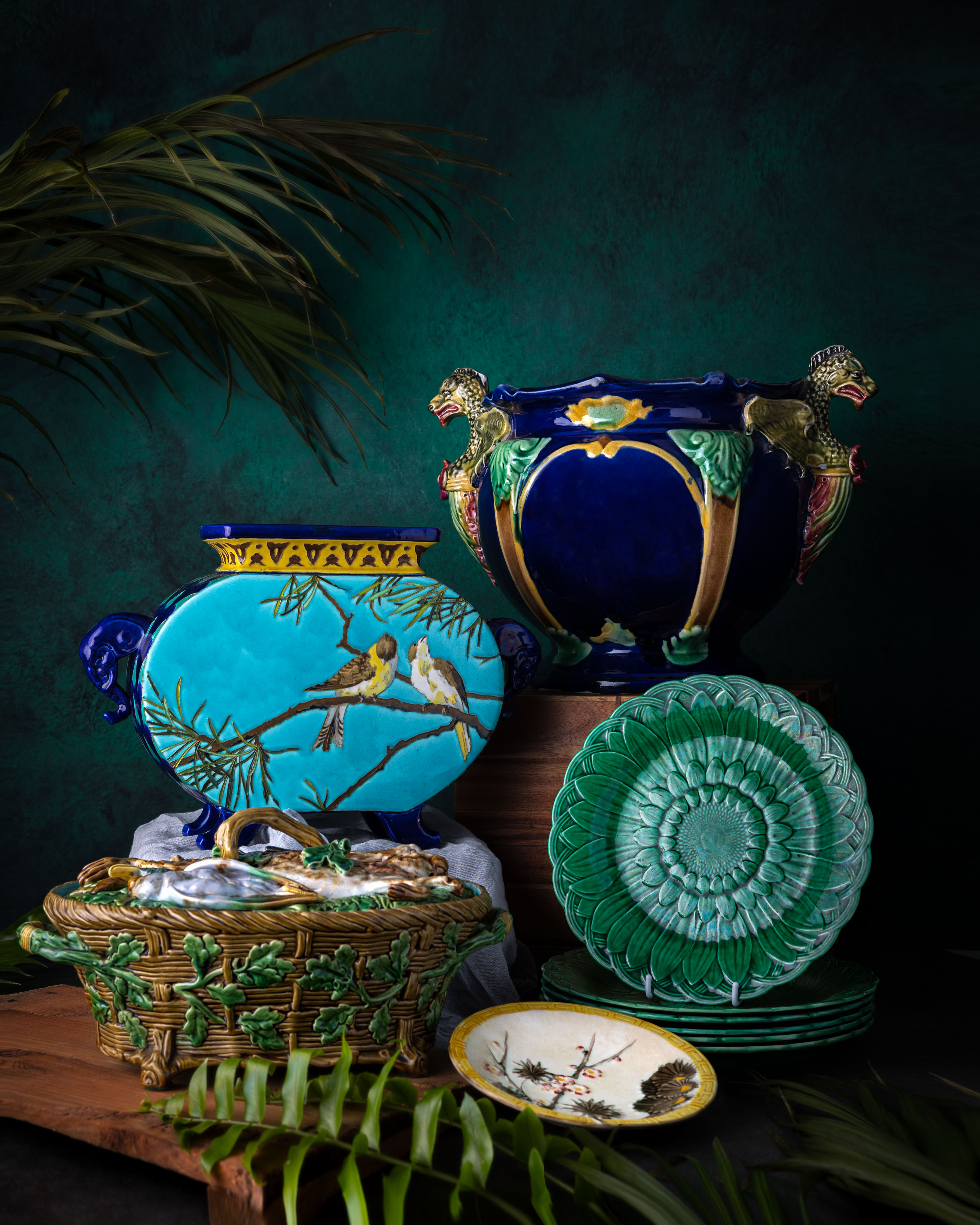
Majolica was a ceramic sensation in the latter half of the nineteenth century. Introduced at the Great Exhibition of 1851, these lead-glazed earthenwares captured consumer interest as affordable and well-made decorative and utilitarian objects, as well as designers’ imaginations for the wares’ endless variations in different styles. The era saw a plethora of design movements which, coupled with improved manufacturing methods developed in the Industrial Revolution, resulted in a surge of majolica production and consumption throughout England and beyond, a “majolica mania.”
This Curation explores the medium of majolica by providing an in-depth look into designers’ incorporation of various stylistic movements of the latter half of the nineteenth century: Victorian Naturalism, Revivalism, the Aesthetic Movement, and Exoticism. Artistic traditions, historical backgrounds, and social contexts will be analyzed to reveal majolica’s enduring ability to fit within a variety of design movements and appeal to ever-evolving consumer tastes.

Majolica was a ceramic sensation in the latter half of the nineteenth century. Introduced at the Great Exhibition of 1851, these lead-glazed earthenwares captured consumer interest as affordable and well-made decorative and utilitarian objects, as well as designers’ imaginations for the wares’ endless variations in different styles. The era saw a plethora of design movements which, coupled with improved manufacturing methods developed in the Industrial Revolution, resulted in a surge of majolica production and consumption throughout England and beyond, a “majolica mania.”
This Curation explores the medium of majolica by providing an in-depth look into designers’ incorporation of various stylistic movements of the latter half of the nineteenth century: Victorian Naturalism, Revivalism, the Aesthetic Movement, and Exoticism. Artistic traditions, historical backgrounds, and social contexts will be analyzed to reveal majolica’s enduring ability to fit within a variety of design movements and appeal to ever-evolving consumer tastes.
Majolica, an Introduction
In 1849 French chemist-designer Léon Arnoux was invited by the director of the English ceramics giant Minton & Co. to create a hard-paste porcelain like that of the Sevres Porcelain Manufactory. The attempt to create a Sevres-like porcelain in Staffordshire ultimately did not come to fruition. Instead, Anoux created a revolutionary range of glazes for earthenwares that became the basis for majolica: a rainbow of brightly colored lead glazes that could be fired simultaneously.2 This significantly reduced the time and cost of the production process; up until then, polychrome wares had to be fired multiple times and with expensive overglaze enamels. Arnoux’s glazes came in a wide palette and contained lead oxide, which gave wares a glossy finish while retaining richly bold colors. Shortly after its invention, Minton & Co. introduced the new majolica wares at the Great Exhibition of 1851, setting into motion the mania that would last throughout the remainder of the century.
Majolica’s success came from its ability to cater to a variety of consumer tastes and budgets. Contemporary art journals noted its ubiquity and praised it as “a profoundly egalitarian product.”3 By the end of the 19th century, majolica was everywhere. It could be found anywhere from modest middle-class homes to large country estates, as flower pots or architectural elements, and not only in Britain but all around the world. Though its earliest versions derive inspiration from its namesake, maiolica, or ceramics of the Italian Renaissance, majolica can hardly be categorized in terms of a single style. Wares took on many forms, each speaking to a different consumer interest or design trend, and each contributing to the medium’s glorious eclecticism. Nearly every movement of the 19th century was fused into these brightly colored ceramics: Victorian Naturalism, Revivalism, the Aesthetic Movement, Exoticism, and much more. Often, more than one movement was incorporated into a single majolica piece, resulting in distinctly majolica designs and expanding consumer appeal.
Majolica struck at the right place at the right time as a confluence of social, cultural, and economic circumstances contributed to the craze: industrialism provided the ability to produce wares on a large scale; scientific and technological innovations improved the manufacturing process; and the expansion of the middle class increased the number of consumers with disposable income to purchase such wares. Additionally, international exhibitions, design publications, and newly-opened museums created a heightened public awareness of different style types and historical art periods.4 All of this coalesced to create a knowledgeable and eager market who bought majolica in enormous quantities, and manufacturers that were more readily able to meet demand.
The Industrial Revolution’s role in the story of majolica was more complex than as mere means of production. Most of the contemporary design movements were a reaction to the Industrial Revolution, which was perceived on the one hand as the height of humankind’s progress and on the other as its moral demise. However, morality was a double-edged sword. While many designers embraced the technical innovations of the Industrial Revolution that enabled more egalitarian distribution of wares by increasing manufacturing capacities and reducing costs, not without some irony others criticized the very industry that enabled the widespread distribution of their creations. Mass production enabled new creations and existing styles to be distributed on a larger scale, but some decried what they perceived to be deterioration in quality, instead advocating for a return to the humble and morally superior hand crafts. Majolica embraced it all to appeal to a spectrum of tastes as well as values, creating not one singular style but a Majolica Movement.
Majolica, an Introduction
In 1849 French chemist-designer Léon Arnoux was invited by the director of the English ceramics giant Minton & Co. to create a hard-paste porcelain like that of the Sevres Porcelain Manufactory. The attempt to create a Sevres-like porcelain in Staffordshire ultimately did not come to fruition. Instead, Anoux created a revolutionary range of glazes for earthenwares that became the basis for majolica: a rainbow of brightly colored lead glazes that could be fired simultaneously.2 This significantly reduced the time and cost of the production process; up until then, polychrome wares had to be fired multiple times and with expensive overglaze enamels. Arnoux’s glazes came in a wide palette and contained lead oxide, which gave wares a glossy finish while retaining richly bold colors. Shortly after its invention, Minton & Co. introduced the new majolica wares at the Great Exhibition of 1851, setting into motion the mania that would last throughout the remainder of the century.
Majolica’s success came from its ability to cater to a variety of consumer tastes and budgets. Contemporary art journals noted its ubiquity and praised it as “a profoundly egalitarian product.”3 By the end of the 19th century, majolica was everywhere. It could be found anywhere from modest middle-class homes to large country estates, as flower pots or architectural elements, and not only in Britain but all around the world. Though its earliest versions derive inspiration from its namesake, maiolica, or ceramics of the Italian Renaissance, majolica can hardly be categorized in terms of a single style. Wares took on many forms, each speaking to a different consumer interest or design trend, and each contributing to the medium’s glorious eclecticism. Nearly every movement of the 19th century was fused into these brightly colored ceramics: Victorian Naturalism, Revivalism, the Aesthetic Movement, Exoticism, and much more. Often, more than one movement was incorporated into a single majolica piece, resulting in distinctly majolica designs and expanding consumer appeal.
Majolica struck at the right place at the right time as a confluence of social, cultural, and economic circumstances contributed to the craze: industrialism provided the ability to produce wares on a large scale; scientific and technological innovations improved the manufacturing process; and the expansion of the middle class increased the number of consumers with disposable income to purchase such wares. Additionally, international exhibitions, design publications, and newly-opened museums created a heightened public awareness of different style types and historical art periods.4 All of this coalesced to create a knowledgeable and eager market who bought majolica in enormous quantities, and manufacturers that were more readily able to meet demand.
The Industrial Revolution’s role in the story of majolica was more complex than as mere means of production. Most of the contemporary design movements were a reaction to the Industrial Revolution, which was perceived on the one hand as the height of humankind’s progress and on the other as its moral demise. However, morality was a double-edged sword. While many designers embraced the technical innovations of the Industrial Revolution that enabled more egalitarian distribution of wares by increasing manufacturing capacities and reducing costs, not without some irony others criticized the very industry that enabled the widespread distribution of their creations. Mass production enabled new creations and existing styles to be distributed on a larger scale, but some decried what they perceived to be deterioration in quality, instead advocating for a return to the humble and morally superior hand crafts. Majolica embraced it all to appeal to a spectrum of tastes as well as values, creating not one singular style but a Majolica Movement.
Victorian Naturalism: Intersections of Science, Morality, and Mortality
In an ever-expanding industrial landscape, Victorians increasingly looked to nature. The Victorian Naturalism style brought the outdoors into the domestic arena and, with it, questions and complications regarding man’s place in nature. Victorians’ perceptions of nature were entangled with issues of science, morality, and mortality, and designers’ realistic depictions of flora and fauna were attempts to address them. Majolica managed to capture these complex relationships in the very place in which they all converged – the dinner table.
Victorian Naturalism: Intersections of Science, Morality, and Mortality
In an ever-expanding industrial landscape, Victorians increasingly looked to nature. The Victorian Naturalism style brought the outdoors into the domestic arena and, with it, questions and complications regarding man’s place in nature. Victorians’ perceptions of nature were entangled with issues of science, morality, and mortality, and designers’ realistic depictions of flora and fauna were attempts to address them. Majolica managed to capture these complex relationships in the very place in which they all converged – the dinner table.
The intersection of nature, science, and morality is perhaps best exemplified in majolica game pie dishes. Game pies, made of fowl, rabbit, or venison inside a pastry crust, have always been a staple of English cuisine. However, it wasn’t until the 18th century that game pie dishes were introduced. As wheat shortages made pie crusts increasingly prohibitive, families sought alternative solutions. As a result, in order to be more economical, households, including that of the royal family, began to make game pies without a crust.5 Made popular by Josiah Wedgwood, game pie dishes were designed to assist these culinary endeavors by holding the pie together without the need for a pastry crust. Form and function connected as Victorian game pie dishes fulfilled the contemporary design ethos: realistically-molded dead game on the dishes referenced the contents within. Though today such seemingly quotidian and casual scenes of death seem odd and even distasteful, especially in the domestic space, these majolica game pie dishes drew upon Victorian society’s rhetoric of death. Intimately connected with science and morality, depictions of death sought to cast light on an individual’s place in the world.
The Artistoric Collection’s game pie dish by Minton & Co. features a hyper-realistic depiction of a rabbit, mallard, and crow alongside ferns, oak leaves, and acorns, all rendered in naturally-colored majolica glazes. This model was designed circa 1855-1857, following the Great Exhibition of 1851 where Minton’s majolica was first introduced. The designer of this game pie dish surely took inspiration from a famous sideboard displayed at the Exhibition by French furniture maker Alexandre Georges Fourdinois (pictured right). Artistic depictions of death in nature can be found in art throughout history, from Bernard Palissy’s rustic earthenwares (often cast from life), to Dutch still lifes, Rococo ornament, and Romantic paintings. The Fourdinois sideboard, however, brought this treatment to decorative and domestic arts, and prompted European and American makers, majolica designers included, to create similar designs throughout the 1850s and 1860s, thereby crystallizing Victorian Naturalism design.
Att. to C.M. Ferrier & F. von Martens. Sideboard of Carved Walnut. Fourdinois., 1851. Photograph, salted paper print, 213 mm x 156 mm. Rijksmuseum, RP-F-F25214-AG.
The Artistoric Collection’s game pie dish by Minton & Co. features a hyper-realistic depiction of a rabbit, mallard, and crow alongside ferns, oak leaves, and acorns, all rendered in naturally-colored majolica glazes. This model was designed circa 1855-1857, following the Great Exhibition of 1851 where Minton’s majolica was first introduced. The designer of this game pie dish surely took inspiration from a famous sideboard displayed at the Exhibition by French furniture maker Alexandre Georges Fourdinois (pictured below). Artistic depictions of death in nature can be found in art throughout history, from Bernard Palissy’s rustic earthenwares (often cast from life), to Dutch still lifes, Rococo ornament, and Romantic paintings. The Fourdinois sideboard, however, brought this treatment to decorative and domestic arts, and prompted European and American makers, majolica designers included, to create similar designs throughout the 1850s and 1860s, thereby crystallizing Victorian Naturalism design.
Att. to C.M. Ferrier & F. von Martens. Sideboard of Carved Walnut. Fourdinois., 1851. Photograph, salted paper print, 213 mm x 156 mm. Rijksmuseum, RP-F-F25214-AG.
Click the image on the left to explore European artistic traditions of portraying death in nature.
Click the image below to explore European artistic traditions of portraying death in nature.
Realistic, deathly imagery was a focus of the Fourdinois sideboard, much like Minton’s game pie dish. In his book, Death in the Dining Room and other Tales of Victorian Culture, Kenneth Ames offers an analysis of Fourdinois sideboard and suggests that this imagery manifests the scientific spirit of a society in an era which “was alive with questions and assertions about hierarchy, dominance, progress, and the relationship of humankind to the rest of the world, present and past.”6 Out of this spirit, such scientific publications as Charles Darwin’s On the Origin of Species (1859) were produced, underlining a society concerned with themes of nature and natural order, and one’s place in the world. The precise depictions of nature on the Minton majolica dish demonstrate an attention to natural detail, painting a bigger picture of Victorians’ close study of the world through scientific pursuits and pastimes such as botany, zoology, and gardening.7
Darwin’s On the Origin of Species, while receiving both praise and criticism from Victorian audiences, crystallized the scientific spirit of the decade. The publication outlines a theory of evolution, put in motion by a new era of Victorian science and sensibilities. It underlines a society concerned with themes of nature and natural order, and one’s place in the world.
While in the 19th century the sciences were increasingly professionalized, there was room for amateurs in Victorian science. Botany was a popular pastime among men, women, and children for its relative ease of entry and moral connotations. Pseudo-scientific publications such as The Ladies’ Companion to the Flower-Garden presented scientific topics to the general public.
Charles Darwin, On the Origin of Species By Means of Natural Selection. London: John Murray, 1859.
Darwin’s On the Origin of Species, while receiving both praise and criticism from Victorian audiences, crystallized the scientific spirit of the decade. The publication outlines a theory of evolution, put in motion by a new era of Victorian science and sensibilities. It underlines a society concerned with themes of nature and natural order, and one’s place in the world.
While in the 19th century the sciences were increasingly professionalized, there was room for amateurs in Victorian science. Botany was a popular pastime among men, women, and children for its relative ease of entry and moral connotations. Pseudo-scientific publications such as The Ladies’ Companion to the Flower-Garden presented scientific topics to the general public.
Majolica brought these pursuits into the home. In a growing urban environment, engagement with nature was an important part of a healthy, hygienic lifestyle. Good health demonstrated an individual’s high moral code and was thought to be obtained through the pursuit of outdoor activities like gardening or plant collecting. Gardening and botany were particularly suitable activities for women and thought to be “a form of moral self-improvement”.8 At the same time, religious enterprises too found a way to harness the Victorian attraction to nature. Challenged by Darwin’s theory of evolution, natural theology proposed an antithesis: close study of nature through botanical practice would reveal a Divine Creator. Botanical and zoological subjects, along with evolutionary and comestible themes, became sources of inspiration for majolica designers who brought this zest from the countryside to domestic settings. Majolica incorporated naturalistic depictions of flora and fauna with a Victorian emphasis on purpose and content: a flower pot or jardinière decorated with flowers, a fern stand decorated with ferns, or an oyster plate decorated with shells. Individuals could now align themselves with these movements within the domestic setting as well, especially since they were also perceived as morally enriching endeavors.
Minton & Co. (English). Planter, ca. 1880. Earthenware with majolica glazes, 25.5 x 37 cm (10 1/16 x 14 9/16 in.). Cooper Hewitt Museum, Gift of Dr. and Mrs. Norton Spritz, 1991-152-1.
This jardinière’s floral decoration reflects its purpose as a planter. Its depiction of ferns also speaks to the Victorian pteridomania, or ‘Fern Fever’, which struck the British Empire, in which hobbyists rushed to collect, document, and display ferns as part of an interest in scientific study and classification.
Both the game pie dish and the sideboard also helped thrust morally correct cultural and societal ideals into Victorian conscience by addressing other themes of nature and natural order. For middle- and upper-class Victorians, dining itself was considered a moral act, yet it was full of underlying messages about order and hegemony:
“To nineteenth-century minds, dining was important because it was basic and because it simultaneously provided an occasion for the display of highly civilized behavior. Here was a charged, even sublime set of realizations. Eating linked nineteenth-century people to all people, of every time and place. Taken one step further, it also linked them to all living things, past or present, that were known to eat—or be eaten. Transforming the commonplace and even bestial act of eating into the civilized ceremony of dining elevated Victorians above all other creatures and most other human beings.”9
Pervading the dining process, and more broadly, the Victorian connection between nature and morality, were mixed ideals of duty and predation. Encouraged in part by the new theory of natural selection, Victorians conceived of humans as superior beings with a responsibility to rule over “lesser” animals. While rulership carried a moral responsibility to protect, leading to advocacy for the abolition of slavery, child labor laws, and the reduction of animal cruelty, it also entailed subjugation. Man’s supremacy over nature led to the exploitation of the natural world and its resources, and the sliding scale of humanity on which humans themselves were also placed legitimized behavior ranging from control of capital distribution and the workforce (as in the Industrial Revolution) to colonization. The imagery of the majolica game pie dish demonstrates dominance over nature by referencing its contents of conquered game with an “eat or be eaten” mentality, and thus speaks to a wider concern for natural order and dominance.
The Minton majolica game pie dish further illustrates the moral duties at the heart of Victorian domestic life. In the 19th century, clearly defined gender roles gained prominence and domestic specialization “required that each room have its discrete functions and that these functions be articulated and enabled by the furnishings in that space.”10 Within the context of specialized domestic spaces, Ames asserts that the Fourdinois sideboard would have been a masculine object since its massive size and iconography “enshrined the conventional masculine roles of hunter and provider.”11 The majolica game pie dish’s role, however, is much more nuanced and displays a tension between these Victorian gender roles. It certainly reflects subliminal predation and triumph over nature, but its iconography is realized in a “feminine” object, as the recently fabricated sphere of domesticity advocated for women’s moral duty to the home, where responsibilities included the procurement of household goods and the preparation of meals.
The Minton majolica game pie dish further illustrates the moral duties at the heart of Victorian domestic life. In the 19th century, clearly defined gender roles gained prominence and domestic specialization “required that each room have its discrete functions and that these functions be articulated and enabled by the furnishings in that space.”10 Within the context of specialized domestic spaces, Ames asserts that the Fourdinois sideboard would have been a masculine object since its massive size and iconography “enshrined the conventional masculine roles of hunter and provider.”11 The majolica game pie dish’s role, however, is much more nuanced and displays a tension between these Victorian gender roles. It certainly reflects subliminal predation and triumph over nature, but its iconography is realized in a “feminine” object, as the recently fabricated sphere of domesticity advocated for women’s moral duty to the home, where responsibilities included the procurement of household goods and the preparation of meals.
George Jones’s ‘Partridge’ game pie dish furthers Victorian notions of nature while illustrating the complex convergences of concurrent design movements. Designed circa 1867-1869, the realistically-molded partridge continues to recall themes of predation exhibited in the Minton game pie dish. The wheat on the body of this dish employs Victorian use of natural designs to reflect the game pie dish’s very function: to stand in as a flour crust. However, the dish also displays the flat patterning of natural forms that became popular during later design movements, marking the transition away from the Victorian Naturalism style to Revivalist and Aesthetic movements. By the 1870s, the home became even more feminized, and male-oriented predatory imagery was replaced with an attitude of gentility. Victorians began to exercise this “genteel avoidance” by favoring other design movements. From matters of national heritage, to utopian prescriptions, the home began being promoted as a sanctuary in which to escape the problems of the world, not address them.
George Jones’s game pie dish demonstrates a moment in which the Victorian cultural mindset shifted. Alternative to the mid-century Naturalistic style were Revival and Aesthetic design movements, both of which rejected their predecessor’s graphic iconography. Ames posits that “violent” objects like the Fourdinois sideboard and game pie dishes were replaced not because they were ugly or outside of the design milieu, but because of the issues of predation and dominance they raised.12 Subsequent generations preferred to suppress these unpalatable matters. These majolica game pie dishes embody issues of predation that are still relevant in the twenty-first century, from exploitation of natural resources to predatory capitalism. Until the imagery completely fell from grace, the mid-century Victorian Naturalistic style found place side by side with the Aesthetic Movement and the Gothic Revival on these majolica game pie dishes, marking a tension between rivaling Victorian design programs and sensibilities.
Revivalism: Fabricating History
The 19th century saw a rise in Revivalist, or historicist, styles as countries were looking to the past in order to establish shared cultural and political values and a shared national history, actual or perceived. Designers explored and established nationalist themes in every medium. Among these Revivalists, majolica makers eagerly took their place to aid in the creation of a national identity, referencing and sometimes even replicating historical designs in a contemporary artform.
Revivalism: Fabricating History
The 19th century saw a rise in Revivalist, or historicist, styles as countries were looking to the past in order to establish shared cultural and political values and a shared national history, actual or perceived. Designers explored and established nationalist themes in every medium. Among these Revivalists, majolica makers eagerly took their place to aid in the creation of a national identity, referencing and sometimes even replicating historical designs in a contemporary artform.
Polychromy During the Renaissance Revival
Polychromy During the Renaissance Revival
Western societies have always admired the Renaissance, itself a revival of Ancient Rome and Greece, as part of an elite cultural heritage. Throughout the latter half of the 19th century, European countries utilized Renaissance aesthetics to support political and cultural aspirations. Renaissance Revival styles were most popular on the Continent, and especially in Italy, where leaders of the newly-formed country sought to unite a nation with a shared national history and common language. Ulisse Cantagalli revived Renaissance maiolica, or tin-glazed earthenware, providing Italian consumers with the opportunity to acquire and take part in the greater spirit of Italian independence and grandeur. German and French designers too utilized Renaissance and Classical elements, as in the Fourdinois sideboard, to create unique Renaissance Revival styles.
Western societies have always admired the Renaissance, itself a revival of Ancient Rome and Greece, as part of an elite cultural heritage. Throughout the latter half of the 19th century, European countries utilized Renaissance aesthetics to support political and cultural aspirations. Renaissance Revival styles were most popular on the Continent, and especially in Italy, where leaders of the newly-formed country sought to unite a nation with a shared national history and common language. Ulisse Cantagalli revived Renaissance maiolica, or tin-glazed earthenware, providing Italian consumers with the opportunity to acquire and take part in the greater spirit of Italian independence and grandeur. German and French designers too utilized Renaissance and Classical elements, as in the Fourdinois sideboard, to create unique Renaissance Revival styles.
In England, Renaissance Revival styles could be found in everything from architecture to furniture, and, of course, majolica. Indeed, it was out of the increasing interest in Renaissance design that majolica was created. The arts of the Renaissance had traditionally been contained within private collections rather than public institutions, but in the 19th century we begin to see a shift towards public collecting, study, and appreciation of 15th- and 16th-century art and design; those at the center of majolica’s invention took part in this growing appreciation.
Léon Arnoux, inventor of majolica, based his wares on French and Italian Renaissance ceramics, and therein lies the etymology of majolica, an anglicization of the Italian maiolica. In his early years at Mintons, Arnoux made several trips to the Continent with factory Director Herbert Minton and his nephew Colin Minton Campbell, where they visited exhibitions and private collections of Renaissance ceramics. They were joined by Henry Cole, director of the South Kensington Museum, who acquired pieces for the museum’s collection. Later, Arnoux and the Minton factory artists often borrowed Renaissance ceramics from the South Kensington Museum for inspiration and copy. Italian maiolica istoriato plates by Orazio Fontana, zoological plaques by French ceramicist Bernard Palissy, and monumental figural sculptures by Luca della Robbia all became sources of inspiration for Minton’s early majolica. Renaissance wares were brightly colored using a combination of under- and overglaze enamels. Arnoux expanded upon the Renaissance palette to include a full rainbow of colors, including turquoise and lilac. These glazes were particularly revolutionary in that they could all be fired simultaneously. The flamboyant glazes were well-received as a respite from the bleak industrial landscape of urban Victorian England. The Renaissance vocabulary of early Minton majolica was distinctly continental. Arnoux invited many European artists to work at the Minton factory who brought with them their heritage of Renaissance artistic traditions. For instance, Palissy was part of Arnoux’s own cultural heritage, as a fellow French potter. All of these Renaissance influences were injected into the creation of majolica.
Majolica’s bold colors were ideal to introduce to the public the Renaissance style as well as the newfound polychromy of Antiquity. Neoclassical designs favored the pure white aesthetic of Antique figures and architecture, and contemporary ceramics in the Neoclassical style exhibited the Classical white imagery of tradition: Wedgwood’s popular jasperware featured white figures on colored stoneware bodies, and Minton’s own Parian porcelain was meant to replicate Antique marble sculptures. However, there were those who held that Ancient Greek and Roman marble was not necessarily monochromatic. Jacques Ignace Hittorff, a German-born French architect was instrumental in changing public perceptions of a colorful Past. Aided by the newly widespread mass-market color printing, Hittorf published L’Architecture Polychrome chez les Grecs (1846) to illustrate a new image of Antiquity.
Inspired by the recent scholarship by Hittorf and others, Albert-Ernest Carrier-Belleuse’s basket shows Renaissance Revival majolica’s colorful treatment of a Classically-inspired subject. The twin Bacchic figures are rendered naturalistically, with skin tones and straw-colored hair instead of stark white bodies. The distinct majolica-turquoise provides a backdrop for the pierced basket and acanthus swags, also colored with signature majolica glazes. Carrier-Belleuse’s basket, and Renaissance Revival majolica in general, paints a picture of a lively historical time period, not stately and stagnant in the past but alive and accessible to a general audience.
John Flaxman (British, 1755–1826) for Josiah Wedgwood. Plaque, ca. 1790. Jasperware, 6 × 9 1/8 in. Metropolitan Museum of Art, Bequest of Mary Clark Thompson, 24.80.39.
Modeled by John Bell (British, 1811/12–1895) for Mintons. The Lord’s Prayer, ca. 1847. Unglazed porcelain (Parian ware), 23.8 × 11.4 × 13.3 cm. Gift of Patricia and Martin Levy, Metropolitan Museum of Art, 2017.144.
Majolica’s bold colors were ideal to introduce to the public the Renaissance style as well as the newfound polychromy of Antiquity. Neoclassical designs favored the pure white aesthetic of Antique figures and architecture, and contemporary ceramics in the Neoclassical style exhibited the Classical white imagery of tradition: Wedgwood’s popular jasperware featured white figures on colored stoneware bodies, and Minton’s own Parian porcelain was meant to replicate Antique marble sculptures.
John Flaxman (British, 1755–1826) for Josiah Wedgwood. Plaque, ca. 1790. Jasperware, 6 × 9 1/8 in. Metropolitan Museum of Art, Bequest of Mary Clark Thompson, 24.80.39.
Modeled by John Bell (British, 1811/12–1895) for Mintons. The Lord’s Prayer, ca. 1847. Unglazed porcelain (Parian ware), 23.8 × 11.4 × 13.3 cm. Gift of Patricia and Martin Levy, Metropolitan Museum of Art, 2017.144.
However, there were those who held that Ancient Greek and Roman marble was not necessarily monochromatic. Jacques Ignace Hittorff, a German-born French architect was instrumental in changing public perceptions of a colorful Past. Aided by the newly widespread mass-market color printing, Hittorf published L’Architecture Polychrome chez les Grecs (1846) to illustrate a new image of Antiquity.
Model by Albert-Ernest Carrier-Belleuse (French, 1824–1887) for Mintons. Basket, 1868. Lead-glazed earthenware (Mintons “Majolica”), 11 in. Metropolitan Museum of Art, Gift of James Parker, in memory of Elizabeth Lyman Frelinghuysen, 1984.119.
Inspired by the recent scholarship by Hittorf and others, Albert-Ernest Carrier-Belleuse’s basket shows Renaissance Revival majolica’s colorful treatment of a Classically-inspired subject. The twin Bacchic figures are rendered naturalistically, with skin tones and straw-colored hair instead of stark white bodies. The distinct majolica-turquoise provides a backdrop for the pierced basket and acanthus swags, also colored with signature majolica glazes. Carrier-Belleuse’s basket, and Renaissance Revival majolica in general, paints a picture of a lively historical time period, not stately and stagnant in the past but alive and accessible to a general audience.
Minton debuted Léon Arnoux’s creation at the London Exhibition of 1851 in a variety of forms and styles. The Renaissance-style majolica wares proved extremely popular, even if few viewers would have understood “what was actually being revived” since Renaissance arts were still relatively new to the general public.15 Renaissance Revival majolica introduced the arts of the Renaissance, the polychromy of Antiquity, and the medium of majolica itself to Victorian audiences, who simply couldn’t get enough.
Gothic Revival: A British History
While Renaissance Revival styles gained popularity, there were those who decried them as inherently deceptive, advocating instead for a more honest style found in the religious architecture of the Middle Ages. The English Gothic Revival movement sought to correct the decline of social standards and morals of contemporary society by introducing into design the principles found in medieval Christian forms. These included humility, honesty, and quality, all achieved through hand-crafted designs true to their form and function. Gothic Revivalists believed that design can dictate behavior and fabricate a morally correct British society based on religious and chivalrous ideals.
Gothic Revival: A British History
While Renaissance Revival styles gained popularity, there were those who decried them as inherently deceptive, advocating instead for a more honest style found in the religious architecture of the Middle Ages. The English Gothic Revival movement sought to correct the decline of social standards and morals of contemporary society by introducing into design the principles found in medieval Christian forms. These included humility, honesty, and quality, all achieved through hand-crafted designs true to their form and function. Gothic Revivalists believed that design can dictate behavior and fabricate a morally correct British society based on religious and chivalrous ideals.
Among the leading figures of the British Gothic Revival movement was architect-designer A. W. N. Pugin, who believed that the ill-designed and cheaply made commodities of the Industrial Revolution epitomized the fallen condition of humanity. For Pugin, and the group of artists, designers, and critics that worked around him, purity of design was not found in the slopes of Athens, or around the city of Rome, but in the arts created by the Christian artisans of the Middle Ages. Among other projects, Pugin spearheaded the Minton manufactory’s Gothic Revival program, and many of his designs were produced in majolica. Realizing the medium’s potential, Pugin incorporated majolica in his designs as early as their debut. For Minton’s 1851 Exhibition display, Pugin designed a great Stove covered in Gothic-style majolica tiles. The form was based upon Northern European ceramic stoves, recalling values of the medieval and Renaissance periods and once more proving majolica’s unique capacity to blend varied ideas and ideals. The Stove premiered alongside Minton’s new Renaissance Revival majolica wares, and helped promote majolica in yet another style.
Matthew Digby Wyatt, The Industrial Arts of the Nineteenth Century, A series of illustrations of the choicest specimens produced by every nation, at the Great Exhibition of Works of Industry, 1851 Vol. 2 (London: Day and Son, 1851). Pl. 106. Smithsonian Libraries.
Augustus Welby Northmore Pugin (British, 1812–1852) for Minton & Co. Tile for Great Exhibition Ceramic Stove, 1851. Earthenware with majolica glazes, 224 mm x 221 mm. British Museum, Donated by Clive and Jane Wainwright, 1994,0502.1.
Even more impressive than Pugin’s Stove was the Minton St. George Fountain, a monumental majolica installation at the London International Exhibition of 1862 featuring Saint George slaying the Dragon atop a thirty-six-foot-tall fountain. The majolica fountain’s iconography reveals how the Gothic Revival went beyond Pugin’s principles of mere “good design” to promote national values. The iconography references a popular Christian legend and artistic motif that can be found throughout the medieval and Renaissance periods. In this legend, Saint George saves a pagan city from a dragon to reward its conversion to Christianity. Saint George’s glorious act of chivalry in saving the virtue of a heathen people can be translated into Great Britain’s presumed role as a global moral exemplar, which was cited as a yet another justification for the nation’s imperialistic efforts. Underlying the the fountain’s assemblage of styles, from the arts of the Middle Ages to the Northern Renaissance to the Italian Baroque, was the spirit of the Victorian Revivalism, further emphasizing the nationalistic purpose of this fountain inscribed with “For England and for Victory.” Though the fountain did not survive the elements and was dismantled in the early twentieth century, its imagery and values appear on other Gothic Revival majolicas, revealing a culture’s embrace of the British myth of chivalry and glory.
Even more impressive than Pugin’s Stove was the Minton St. George Fountain, a monumental majolica installation at the London International Exhibition of 1862 featuring Saint George slaying the Dragon atop a thirty-six-foot-tall fountain.
The majolica fountain’s iconography reveals how the Gothic Revival went beyond Pugin’s principles of mere “good design” to promote national values. The iconography references a popular Christian legend and artistic motif that can be found throughout the medieval and Renaissance periods. In this legend, Saint George saves a pagan city from a dragon to reward its conversion to Christianity. Saint George’s glorious act of chivalry in saving the virtue of a heathen people can be translated into Great Britain’s presumed role as a global moral exemplar, which was cited as a yet another justification for the nation’s imperialistic efforts. Underlying the the fountain’s assemblage of styles, from the arts of the Middle Ages to the Northern Renaissance to the Italian Baroque, was the spirit of the Victorian Revivalism, further emphasizing the nationalistic purpose of this fountain inscribed with “For England and for Victory.” Though the fountain did not survive the elements and was dismantled in the early twentieth century, its imagery and values appear on other Gothic Revival majolicas, revealing a culture’s embrace of the British myth of chivalry and glory.
Gothic Revival designs in majolica were not limited to the monumental. The Artistoric Collection’s jardinière by Thomas Forester echoes the values evoked by the Gothic Revival movement. The jardinière’s twin dragon handles bring to mind not only the legend of Saint George and the Dragon, but a whole slew of Anglo myths featuring dragon, or “worm,” slayers: Beowulf, the Laird of Lariston, and Sir Guy, Earl of Warwick, among others. These characters and their heroic endeavors were part of a national folklore, placing the British nation on the same level as Ancient Rome and Greece through an established mythological tradition. This tradition was Christian rather than pagan: dragons were identified with Satan (Revelation 12:9), and their presence in medieval, and, subsequently Gothic Revival, art symbolized the defeat of evil.
Gothic Revival designs in majolica were not limited to the monumental. The Artistoric Collection’s jardinière by Thomas Forester echoes the values evoked by the Gothic Revival movement.
The jardinière’s twin dragon handles bring to mind not only the legend of Saint George and the Dragon, but a whole slew of Anglo myths featuring dragon, or “worm,” slayers: Beowulf, the Laird of Lariston, and Sir Guy, Earl of Warwick, among others. These characters and their heroic endeavors were part of a national folklore, placing the British nation on the same level as Ancient Rome and Greece through an established mythological tradition. This tradition was Christian rather than pagan: dragons were identified with Satan (Revelation 12:9), and their presence in medieval, and, subsequently Gothic Revival, art symbolized the defeat of evil.
In true majolica eclecticism, Forester’s jardinière also contains references to the Renaissance with its Corinthian-style columns and bright primary colors. The overall effect of this piece is one of Western cultural heritage. Forester’s design reflects the nineteenth-century English desire to become a political, cultural, industrial, and moral world power by utilizing the principles and iconographies of historic styles in the contemporary medium of majolica.
The Aesthetic Movement
While majolica managed to incorporate many design movements throughout its development, it proved a particularly apt medium for the tenets of the Aesthetic Movement. Championing “Art for Art’s Sake,” the Aesthetic Movement stood in opposition to Victorian moralizing wares and Revivalists’ prescriptive homages to the past. The movement began in the years following the Great Exhibition of 1851, when radical young artists began to denounce Victorian designs like majolica game pie dishes as vulgar and ostentatious. Aesthetes, or followers of the Aesthetic Movement, reacted against industrialism and advocated for objects that emphasized beauty over social or political themes. They blurred the line between craft, fine art, and decorative arts to bring beauty into everyday life, and particularly to the home, which they viewed as a canvas for artistic expression and a sanctuary from the blandness of industrial life.
The Aesthetic Movement
While majolica managed to incorporate many design movements throughout its development, it proved a particularly apt medium for the tenets of the Aesthetic Movement. Championing “Art for Art’s Sake,” the Aesthetic Movement stood in opposition to Victorian moralizing wares and Revivalists’ prescriptive homages to the past. The movement began in the years following the Great Exhibition of 1851, when radical young artists began to denounce Victorian designs like majolica game pie dishes as vulgar and ostentatious. Aesthetes, or followers of the Aesthetic Movement, reacted against industrialism and advocated for objects that emphasized beauty over social or political themes. They blurred the line between craft, fine art, and decorative arts to bring beauty into everyday life, and particularly to the home, which they viewed as a canvas for artistic expression and a sanctuary from the blandness of industrial life.
The Aesthetic Movement ethos of beauty was united with functional, everyday items in wares such as the Wedgwood majolica ‘Sunflower’ pattern dinner plates. The sunflower, alongside the calla lily and peacock feather, became an emblem of the Movement. The flower’s colors, green and yellow, were also representative of Aesthetic Movement design. Not only were these two colors linked to nature, but they were also colors which were deemed unsuitable and even scandalous in proper society. Yellow, in fact, was associated with indecency and mortification, and thus “had long been the victim of chromatic denigration, from its association with opium dens in the Far East, Dickensian descriptions of sallow flesh, and sexual impropriety.”16 Of course, this taboo connotation was irresistible to the Aesthetes. They decorated their showroom, the Grosvenor Gallery, with green and yellow silk wallcoverings (“greenery-yallery”), and featured the colors in fine and decorative arts, architecture, and interiors alike. It seems only natural that the sunflower came to represent this counter-culture. Oscar Wilde was an emphatic advocate of the flower, speaking at length about its aesthetic qualities and suitability for design. Almost every depiction of the flamboyant author paired him with the sunflower.
Oscar Wilde, one of the Aesthetic Movement’s leading figures, was almost always depicted with sunflowers. Click below to see some satirical examples of his portrayal in popular culture.
“You have heard, I think, a few of you, of two flowers connected with the aesthetic movement in England, and said (I assure you, erroneously) to be the food of some aesthetic young men. Well, let me tell you that the reason we love the lily and the sunflower, in spite of what Mr. Gilbert may tell you, is not for any vegetable fashion at all. It is because these two lovely flowers are in England the two most perfect models of design, the most naturally adapted for decorative art – the gaudy leonine beauty of the one and the precious loveliness of the other giving to the artist the most entire and perfect joy. And so with you: let there be no flower in your meadows that does not wreathe its tendrils around your pillows, no little leaf in your Titan forests that does not lend its form to design, no curving spray of wild rose or brier that does not live for ever in carven arch or window or marble, no bird in your air that is not giving the iridescent wonder of its colour, the exquisite curves of its wings in flight, to make more precious the preciousness of simple adornment.”
Oscar Wilde, “The English Renaissance of Art,” 1882
The desirable green and yellows could find no better match than with majolica and its newly developed brightly colored lead glazes with which to paint beautiful domestic interiors suitable for everyday life. The Wedgwood company, seeking to capitalize on the trend, made use of the medium for its green majolica sunflower plates. But while the dinner set in the Artistoric Collection was glazed using the émail ombrant technique, polychrome examples exist as well and depict the flower in both of its natural colors, yellow and green. Middle- and upper-class consumers responded positively to the ‘Sunflower’ pattern, if not to the Aesthetic Movement’s somewhat highbrow ideals.
Though the ‘Sunflower’ pattern, first produced in 1860, proved extremely popular and the taste for it persisted well into the 20th century, the Aesthetic movement was more short lived. Democratic beauty, it turned out, was difficult to achieve, and the Aesthetic Movement’s controversial ideals sometimes rang hollow. The Movement’s followers rejected the very industrialism that made widespread decorative arts production, and consumption, possible. Aesthetes’ lofty principles and so-called ‘Cult of Beauty’ were rather inaccessible to the general public, and their fine and decorative arts were largely only afforded by the affluent. Thus Aesthetes met their fair share of criticism, and many of the Movement’s ideals and leading figures were satirized in popular culture. As the Aesthetic style developed, designs became darker and erotic, filled with what were considered dangerous ideas. Public skepticism culminated with the trial and conviction of Oscar Wilde for homosexuality in 1895, and the Aesthetic Movement came to an end shortly thereafter.
Japonisme and Exoticism
The ever-innovating Wedgwood manufactory was soon to capitalize on another evolving trend in the 1880s, exoticism. A change in consumer taste and shifts in the Aesthetic Movement’s preferred color palette made way for majolica wares in the Argenta color scheme, consisting of muted colors on cream grounds. Wedgwood’s Argenta wares proved extremely popular within the context of the Aesthetic Movement’s japonisme trend, and many manufactories in England and abroad quickly introduced a similar palette for their own majolica wares.
Japonisme and Exoticism
The ever-innovating Wedgwood manufactory was soon to capitalize on another evolving trend in the 1880s, exoticism. A change in consumer taste and shifts in the Aesthetic Movement’s preferred color palette made way for majolica wares in the Argenta color scheme, consisting of muted colors on cream grounds. Wedgwood’s Argenta wares proved extremely popular within the context of the Aesthetic Movement’s japonisme trend, and many manufactories in England and abroad quickly introduced a similar palette for their own majolica wares.
Japonisme was an influential branch of Aesthetic design which valued the exotic, non-Western designs as morally superior, free from the corrupting influences of European industrialism and capitalism. Following Japan’s forced opening in 1854, European interest in Japanese and other Asian goods exploded. Expositions and world’s fairs, such as the London International Exhibition of 1862 and the Paris Expositions Universelles of 1867 and 1878, were particularly influential in introducing the “Far East” to European and American audiences. Publications, such as Christopher Dresser’s Japan, Its Architecture, Art and Art-Manufactures (1882), inspired designers and retailers like Wedgwood to adapt Japanese motifs in their own designs. However, Western interpretations of Eastern designs largely ignored their cultural context and instead appreciated them either for their aesthetic merits, their sense of “otherness,” or both. Exoticism became very popular in the late 19th century, especially among majolica designers, who combined a variety of Eastern-inspired motifs with unique colorways to serve Western ideas of a romanticized East.
The term “japonisme,” coined by French art critic Philippe Burty in 1872, encapsulated not only Japanese art but that of Chinese, Korean, and other East Asian cultures and created one “exotic” style. The ‘Lincoln’ pattern dessert dishes in the Argenta palette by Wedgwood featured the Three Friends of Winter motif, itself a pattern with a rich history of trans-cultural exchange. Originally a Chinese artistic convention showing the pine, plum, and bamboo together to represent steadfastness, perseverance, and resilience, it was later adopted by Japanese and other East Asian cultures. Adoption and adaptation of this motif into European japonisme design echoed its history and marked a new phase in its cycle, though now, suiting an idealized Western view of the East that conflated Asian cultures and emptied designs of their original meanings.
“For his residence, earth was piled to form a hill and a hundred plum trees, which along with lofty pines and tall bamboo comprise the friends of winter, were planted.
即其居累土為山,種梅百本,與喬松,脩篁為歲寒友。”Record of the Five-cloud Plum Cottage (五雲梅舍記) from The Clear Mountain Collection (霽山集) by the Song dynasty writer Lin Jingxi (林景熙, 1242–1310)
The term “japonisme,” coined by French art critic Philippe Burty in 1872, encapsulated not only Japanese art but that of Chinese, Korean, and other East Asian cultures and created one “exotic” style. The ‘Lincoln’ pattern dessert dishes in the Argenta palette by Wedgwood featured the Three Friends of Winter motif, itself a pattern with a rich history of trans-cultural exchange. Originally a Chinese artistic convention showing the pine, plum, and bamboo together to represent steadfastness, perseverance, and resilience, it was later adopted by Japanese and other East Asian cultures. Adoption and adaptation of this motif into European japonisme design echoed its history and marked a new phase in its cycle, though now, suiting an idealized Western view of the East that conflated Asian cultures and emptied designs of their original meanings.
“For his residence, earth was piled to form a hill and a hundred plum trees, which along with lofty pines and tall bamboo comprise the friends of winter, were planted.
即其居累土為山,種梅百本,與喬松,脩篁為歲寒友。”Record of the Five-cloud Plum Cottage (五雲梅舍記) from The Clear Mountain Collection (霽山集) by the Song dynasty writer Lin Jingxi (林景熙, 1242–1310)
Click on the image to view the wide variety of colors and shapes produced in the Lincoln pattern.
Wedgwood’s ‘Lincoln’ dessert dishes in the Argenta palette placed the Friends of Winter motif within an anachronous Greek key border. However, the ‘Lincoln’ pattern was also produced in the traditional vibrant majolica colors on different wares (see left). Since its inception, the Wedgwood factory had proved its adeptness for manufacturing by using interchangeable designs, patterns, and colors, all catering to different tastes. This enabled the factory to quickly produce majolica pieces that were exotic, unique, and of high-quality at a lower expense. In doing so, Wedgwood appealed to a wide variety of design interests and therein found success with its majolica wares that celebrated the japonisme style in majolica’s characteristic eclecticism.
Wedgwood’s ‘Lincoln’ dessert dishes in the Argenta palette placed the Friends of Winter motif within an anachronous Greek key border. However, the ‘Lincoln’ pattern was also produced in the traditional vibrant majolica colors on different wares (see below).
Click on the image to view the wide variety of colors and shapes produced in the Lincoln pattern.
Since its inception, the Wedgwood factory had proved its adeptness for manufacturing by using interchangeable designs, patterns, and colors, all catering to different tastes. This enabled the factory to quickly produce majolica pieces that were exotic, unique, and of high-quality at a lower expense. In doing so, Wedgwood appealed to a wide variety of design interests and therein found success with its majolica wares that celebrated the japonisme style in majolica’s characteristic eclecticism.
On the other side of the English Channel, other manufactories were also producing their own majolica wares. This jardinière, made by the French manufactory Sarreguemines in 1880-1890, also displays the exoticizing and eclectic japonisme style, and reveals both the style’s and majolica’s widespread Western use. The jardinière, glazed in majolica’s unmistakable turquoise color, is filled with Eastern inspiration. The front shows a naturalistic yet painterly pair of birds on a pine branch; the reverse shows a plum blossom. Both the pine branch and plum blossom may be recognized from the Wedgwood ‘Lincoln’ pattern as part of the trans-cultural Three Friends of Winter motif. The jardinière’s omission of the third “friend,” bamboo, further demonstrates japonisme’s designers’ disposition for aesthetic choices over the meaningful iconographies they adapted, contributing even more to a romanticized version of the East. The jardinière’s shape, twin cobalt elephant handles, and faux cloisonné effect all derive from Chinese sources. Sarreguemines’s jardinière is not without its complexities, characteristic of all majolica design movements explored in this Curation. Though created in France, this jardinière’s style and colors certainly share a similar language with its English counterparts, showing that the French were undergoing something of a majolique manie themselves.
On the other side of the English Channel, other manufactories were also producing their own majolica wares. This jardinière, made by the French manufactory Sarreguemines in 1880-1890, also displays the exoticizing and eclectic japonisme style, and reveals both the style’s and majolica’s widespread Western use.
Sarreguemines (French). Jardinière, 1880-1890. Majolica-glazed earthenware with enamels, 13 1/2 in. L x 3 3/4 in. W x 8 3/4 in. H. From the Artistoric Collection.
The jardinière, glazed in majolica’s unmistakable turquoise color, is filled with Eastern inspiration. The front shows a naturalistic yet painterly pair of birds on a pine branch; the reverse shows a plum blossom. Both the pine branch and plum blossom may be recognized from the Wedgwood ‘Lincoln’ pattern as part of the trans-cultural Three Friends of Winter motif. The jardinière’s omission of the third “friend,” bamboo, further demonstrates japonisme’s designers’ disposition for aesthetic choices over the meaningful iconographies they adapted, contributing even more to a romanticized version of the East. The jardinière’s shape, twin cobalt elephant handles, and faux cloisonné effect all derive from Chinese sources.
Chinese, Ming dynasty (1368–1644). Vase. Pottery, H. 19 in. Metropolitan Museum of Art, 18.69.2.
Sarreguemines’s jardinière is not without its complexities, characteristic of all majolica design movements explored in this Curation. Though created in France, this jardinière’s style and colors certainly share a similar language with its English counterparts, showing that the French were undergoing something of a majolique manie themselves.
Conclusion
Léon Arnoux and Herbert Minton could never imagine the frenzy they set in motion at the Great Exhibition in 1851. Soon after its introduction in England, majolica began to appear in the United States and Continental Europe, and design variations in the medium expanded exponentially. The long-lived success of this brightly colored medium came precisely from its ability to adapt to ever-changing tastes and attitudes. Through its many adaptations and iterations, however, majolica became even more difficult to characterize.
Majolica game pie dishes embodied the ideals of Victorian Naturalism at a time of social transition, and were able to negotiate changing contemporary attitudes towards natural and social order. Renaissance and Gothic Revivalists, each with their own agendas, also made use of majolica. From monumental sculpture to home decor, the medium was readily able to embody and communicate national and moralizing ideals. Aesthetes and lovers of the exotic also found solace in majolica. Majolica’s ability to easily conform to changing trends of color and theme made it particularly suitable to capture the Aesthetic Movement’s constantly evolving fads and ideas.
When looking at this assemblage of majolica created throughout the nineteenth century, it may be difficult to find a common thread. Almost every contemporary design movement left its mark on majolica, whose styles varied greatly in both aesthetics and ideals. Majolica was more than just a medium. A deeper look into the ceramics reveals similar means of production, a global audience, and an inherent eclecticism. Endless, and sometimes even opposing, artistic movements and cultural ideals were all united under a strikingly brilliant glaze pointing to a movement in its own sake, the Majolica Movement.
Conclusion
Léon Arnoux and Herbert Minton could never imagine the frenzy they set in motion at the Great Exhibition in 1851. Soon after its introduction in England, majolica began to appear in the United States and Continental Europe, and design variations in the medium expanded exponentially. The long-lived success of this brightly colored medium came precisely from its ability to adapt to ever-changing tastes and attitudes. Through its many adaptations and iterations, however, majolica became even more difficult to characterize.
Majolica game pie dishes embodied the ideals of Victorian Naturalism at a time of social transition, and were able to negotiate changing contemporary attitudes towards natural and social order. Renaissance and Gothic Revivalists, each with their own agendas, also made use of majolica. From monumental sculpture to home decor, the medium was readily able to embody and communicate national and moralizing ideals. Aesthetes and lovers of the exotic also found solace in majolica. Majolica’s ability to easily conform to changing trends of color and theme made it particularly suitable to capture the Aesthetic Movement’s constantly evolving fads and ideas.
When looking at this assemblage of majolica created throughout the nineteenth century, it may be difficult to find a common thread. Almost every contemporary design movement left its mark on majolica, whose styles varied greatly in both aesthetics and ideals. Majolica was more than just a medium. A deeper look into the ceramics reveals similar means of production, a global audience, and an inherent eclecticism. Endless, and sometimes even opposing, artistic movements and cultural ideals were all united under a strikingly brilliant glaze pointing to a movement in its own sake, the Majolica Movement.
Citation
Tichenor, Bailey. “The Majolica Movement.” Artistoric, 12 August 2021. https://artistoric.com/majolica/.
Citation
Tichenor, Bailey. “The Majolica Movement.” Artistoric, 12 August 2021. https://artistoric.com/majolica/.
Bibliography & Suggested Readings
Ames, Kenneth L. “Death in the Dining Room.” In Death in the Dining Room and Other Tales of Victorian Culture, 44–96. Philadelphia, PA: Temple University Press, 1995.
Arbuthnott, Catherine and Susan Weber. “Thomas Forester, the ‘Potter King’ of Longton.” In Majolica Mania: Transatlantic Pottery in England and the United States, 1850–1915 vol. 2, ed. Susan Weber et al. New Haven: Yale University Press, 2020. Identical example illus. pg 405 Fig. 24.42.
Atterbury, Paul. “‘Low, vulgar, even barbarous’: Majolica; A Historical Overview.” In Majolica Mania: Transatlantic Pottery in England and the United States, 1850–1915 vol. 1, ed. Susan Weber et al, 1833-31. New Haven: Yale University Press, 2020.
Bastas, Dimitrios N. “Spotlight: Wedgwood’s Lincoln Pattern.” Glazed and Confused, May 24, 2011. http://etruscanmajolica.blogspot.com/2011/05/spotlight-wedgwoods-lincoln-pattern.html.
Blake-Roberts, Gaye and Susan Weber. “From Teapots to Flowerpots: The Use of Majolica in the Victorian Home.” In Majolica Mania: Transatlantic Pottery in England and the United States, 1850–1915 vol. 1, ed. Susan Weber et al, 110-143. New Haven: Yale University Press, 2020.
Cooke, Simon. “The Remains of the Day: Death and Dying in Victorian Illustration.” The Victorian Web, April 20, 2021. https://victorianweb.org/art/illustration/misc/death.html.
Decker, Emile. Sarreguemines au XIXème siècle : la faïencerie Utzschneider, 1790-1914 contribution à une histoire des goûts et des styles au XIXème siècle. Art et histoire de l’art. Université Nancy 2, 2001. Français. ffNNT : 2001NAN21007ff. Fftel-01776218f
Goodby, Miranda. “‘The productions of this firm stand pre-eminent’: The Minton Factory and Majolica.” In Majolica Mania: Transatlantic Pottery in England and the United States, 1850–1915 vol. 2, ed. Susan Weber et al, 1-31. New Haven: Yale University Press, 2020.
“An Introduction to the Aesthetic Movement.” Victoria & Albert Museum. https://www.vam.ac.uk/articles/an-introduction-to-the-aesthetic-movement.
Jesse, Captain William. The Life of George Brummell, Esq., Commonly Called Beau Brummell. London: Saunders and Otley, 1844.
Kirkham, Pat, and Amy F Ogata. “Europe 1830-1900.” In History of Design: Decorative Arts and Material Culture, 1400-2000, ed. Pat Kirkham and Susan Weber, 416–35. New Haven: Yale University Press, 2013.
Majolica Mania: Transatlantic Pottery in England and the United States, 1850–1915. ed. Susan Weber et al. New Haven: Yale University Press, 2020.
Nelson, E. Charles. “”Helianthus Annuus” ‘Oscar Wilde’: Some Notes on Oscar and the Cult[ivation] of Sunflowers.” The Wildean, no. 43 (2013): 2-25. Accessed June 16, 2021. http://www.jstor.org/stable/45270258.
“Sunflowers and Aesthetic Decadence: An Embroidered White Cotton Wrapper, 1880.” Hindman, December 8, 2020. https://hindmanauctions.com/blog/sunflowers-and-aesthetic-decadence-an-embroidered-white-cotton-wrapper-1880#_ftn6.
Wallis, Rebecca. “Majolica: Sources of Inspiration.” In Majolica Mania: Transatlantic Pottery in England and the United States, 1850–1915 vol. 1, ed. Susan Weber et al, 34-69. New Haven: Yale University Press, 2020.
Weber, Susan. “Introduction.” In Majolica Mania: Transatlantic Pottery in England and the United States, 1850–1915 vol. 1, ed. Susan Weber et al, 1-17. New Haven: Yale University Press, 2020.
Bibliography & Suggested Readings
Ames, Kenneth L. “Death in the Dining Room.” In Death in the Dining Room and Other Tales of Victorian Culture, 44–96. Philadelphia, PA: Temple University Press, 1995.
Arbuthnott, Catherine and Susan Weber. “Thomas Forester, the ‘Potter King’ of Longton.” In Majolica Mania: Transatlantic Pottery in England and the United States, 1850–1915 vol. 2, ed. Susan Weber et al. New Haven: Yale University Press, 2020. Identical example illus. pg 405 Fig. 24.42.
Atterbury, Paul. “‘Low, vulgar, even barbarous’: Majolica; A Historical Overview.” In Majolica Mania: Transatlantic Pottery in England and the United States, 1850–1915 vol. 1, ed. Susan Weber et al, 1833-31. New Haven: Yale University Press, 2020.
Bastas, Dimitrios N. “Spotlight: Wedgwood’s Lincoln Pattern.” Glazed and Confused, May 24, 2011. http://etruscanmajolica.blogspot.com/2011/05/spotlight-wedgwoods-lincoln-pattern.html.
Blake-Roberts, Gaye and Susan Weber. “From Teapots to Flowerpots: The Use of Majolica in the Victorian Home.” In Majolica Mania: Transatlantic Pottery in England and the United States, 1850–1915 vol. 1, ed. Susan Weber et al, 110-143. New Haven: Yale University Press, 2020.
Cooke, Simon. “The Remains of the Day: Death and Dying in Victorian Illustration.” The Victorian Web, April 20, 2021. https://victorianweb.org/art/illustration/misc/death.html.
Decker, Emile. Sarreguemines au XIXème siècle : la faïencerie Utzschneider, 1790-1914 contribution à une histoire des goûts et des styles au XIXème siècle. Art et histoire de l’art. Université Nancy 2, 2001. Français. ffNNT : 2001NAN21007ff. Fftel-01776218f
Goodby, Miranda. “‘The productions of this firm stand pre-eminent’: The Minton Factory and Majolica.” In Majolica Mania: Transatlantic Pottery in England and the United States, 1850–1915 vol. 2, ed. Susan Weber et al, 1-31. New Haven: Yale University Press, 2020.
“An Introduction to the Aesthetic Movement.” Victoria & Albert Museum. https://www.vam.ac.uk/articles/an-introduction-to-the-aesthetic-movement.
Jesse, Captain William. The Life of George Brummell, Esq., Commonly Called Beau Brummell. London: Saunders and Otley, 1844.
Kirkham, Pat, and Amy F Ogata. “Europe 1830-1900.” In History of Design: Decorative Arts and Material Culture, 1400-2000, ed. Pat Kirkham and Susan Weber, 416–35. New Haven: Yale University Press, 2013.
Majolica Mania: Transatlantic Pottery in England and the United States, 1850–1915. ed. Susan Weber et al. New Haven: Yale University Press, 2020.
Nelson, E. Charles. “”Helianthus Annuus” ‘Oscar Wilde’: Some Notes on Oscar and the Cult[ivation] of Sunflowers.” The Wildean, no. 43 (2013): 2-25. Accessed June 16, 2021. http://www.jstor.org/stable/45270258.
“Sunflowers and Aesthetic Decadence: An Embroidered White Cotton Wrapper, 1880.” Hindman, December 8, 2020. https://hindmanauctions.com/blog/sunflowers-and-aesthetic-decadence-an-embroidered-white-cotton-wrapper-1880#_ftn6.
Wallis, Rebecca. “Majolica: Sources of Inspiration.” In Majolica Mania: Transatlantic Pottery in England and the United States, 1850–1915 vol. 1, ed. Susan Weber et al, 34-69. New Haven: Yale University Press, 2020.
Weber, Susan. “Introduction.” In Majolica Mania: Transatlantic Pottery in England and the United States, 1850–1915 vol. 1, ed. Susan Weber et al, 1-17. New Haven: Yale University Press, 2020.


